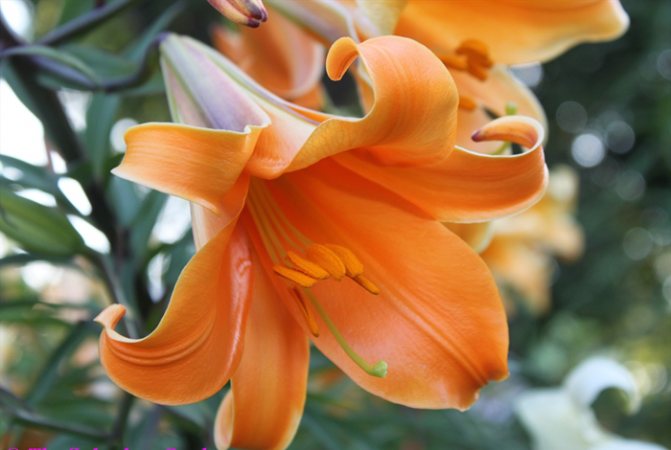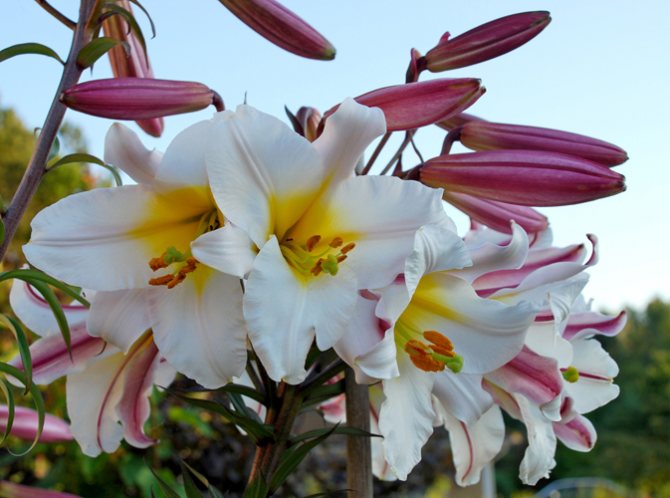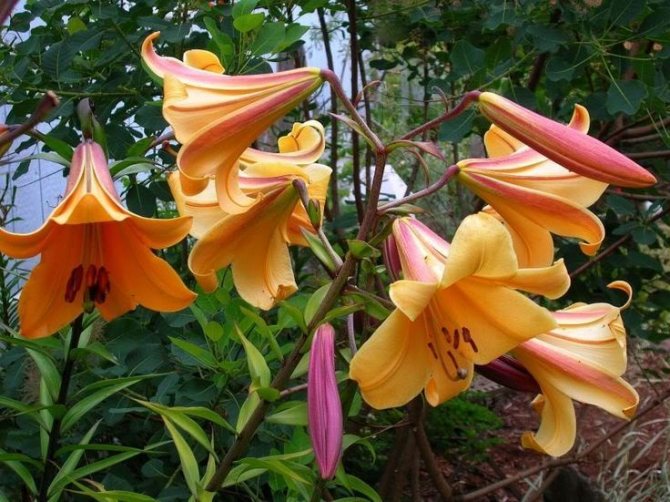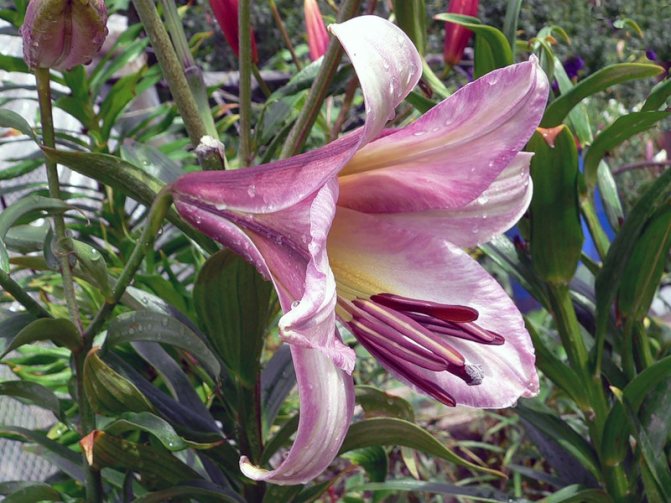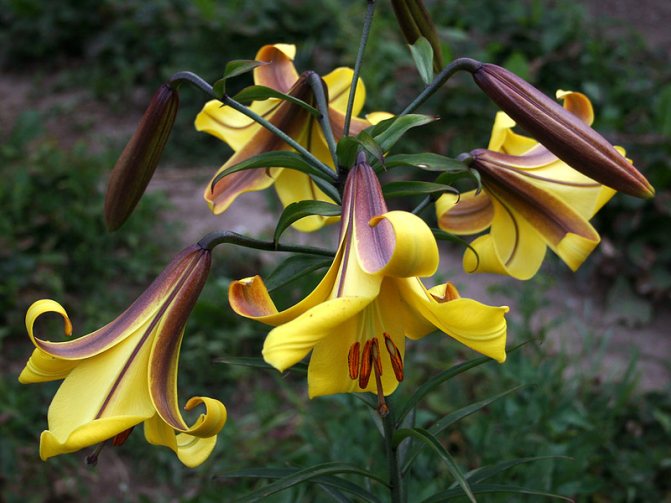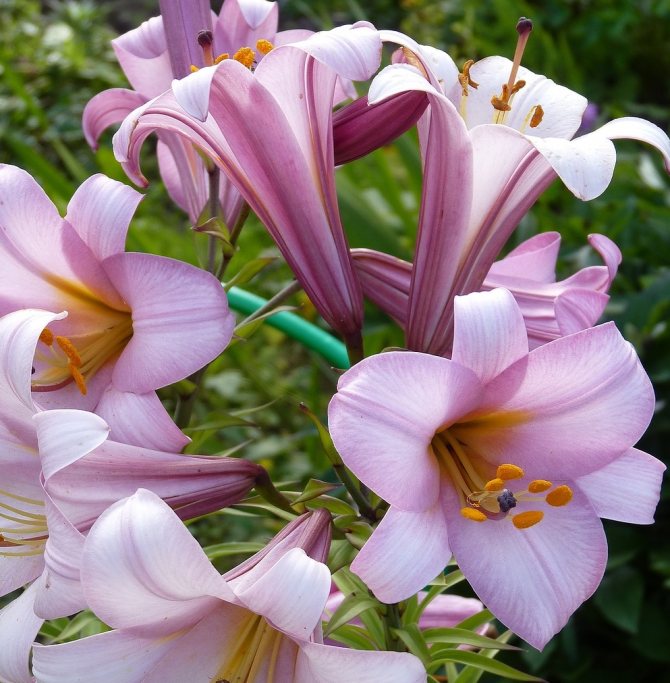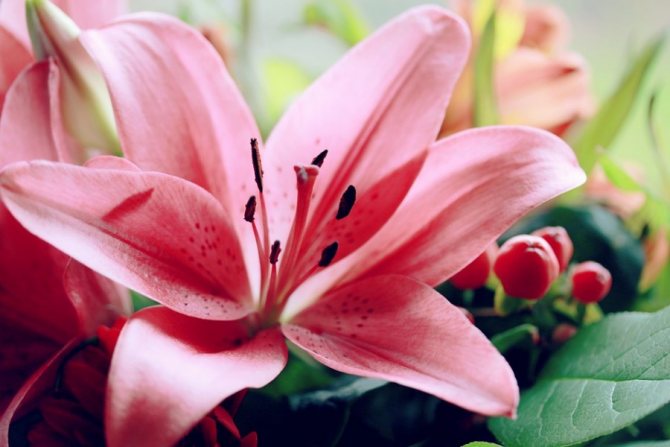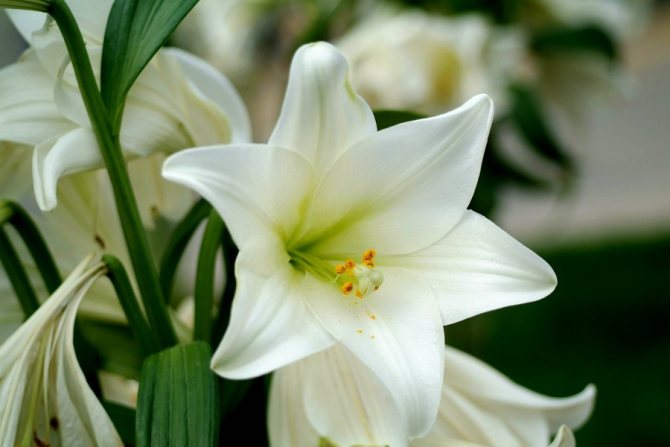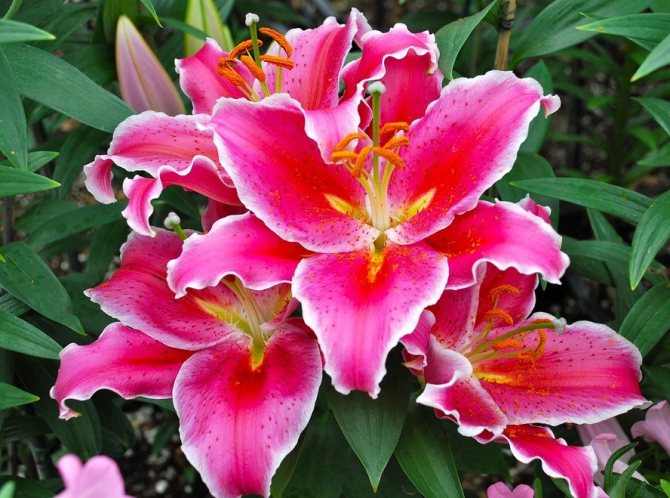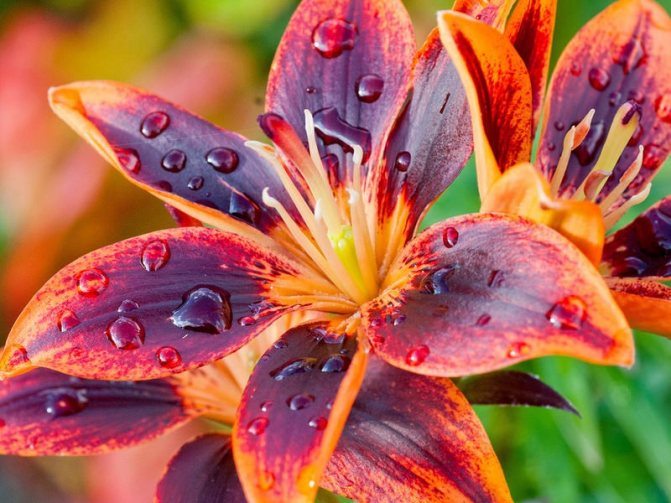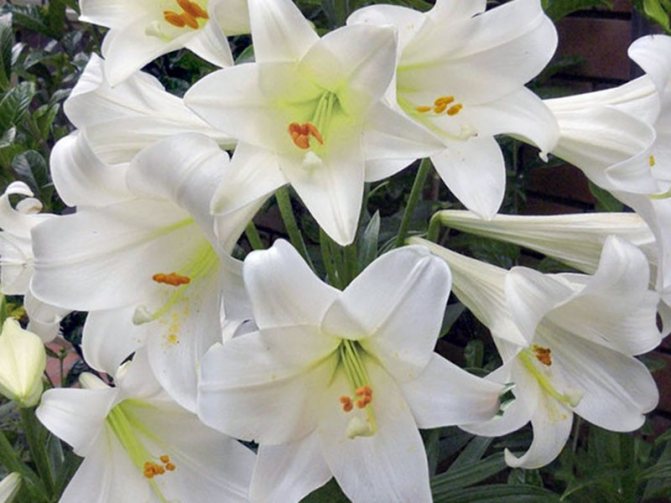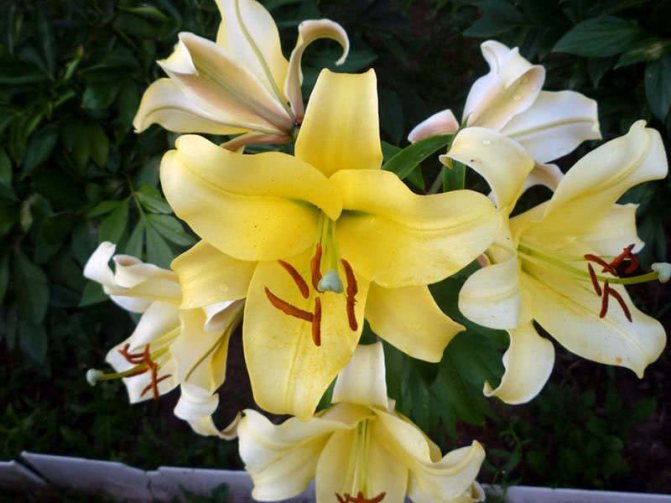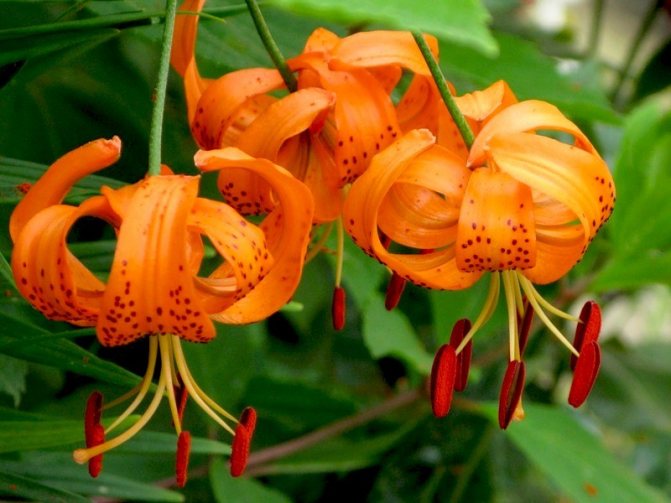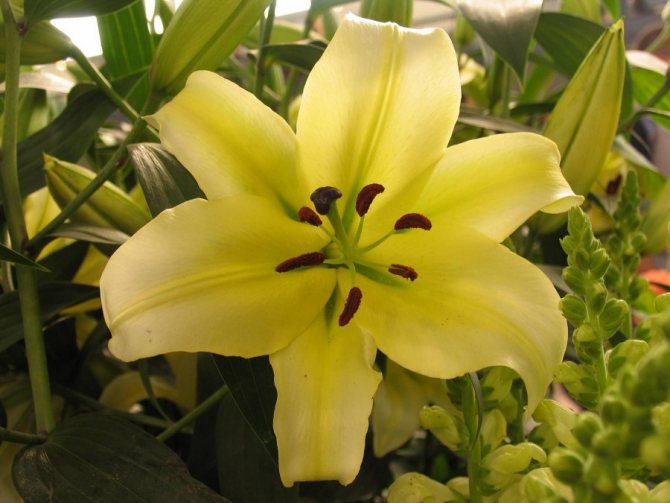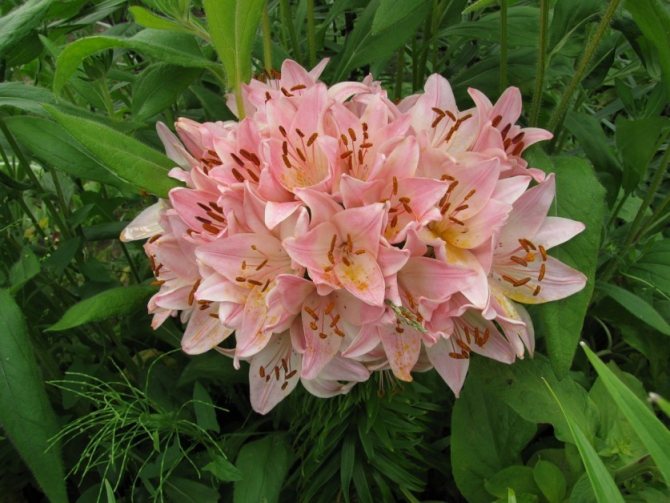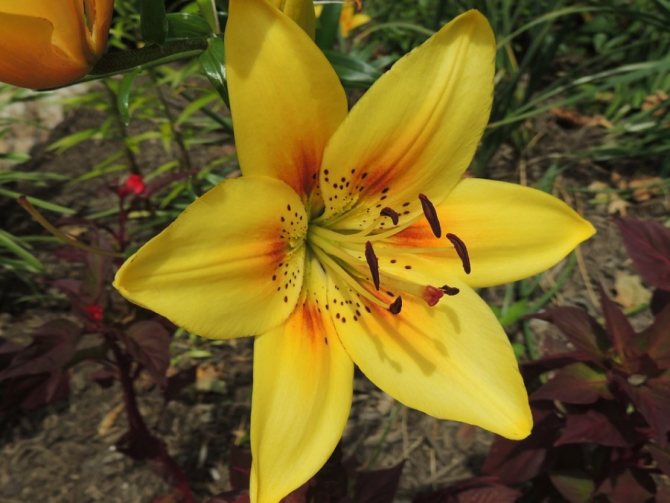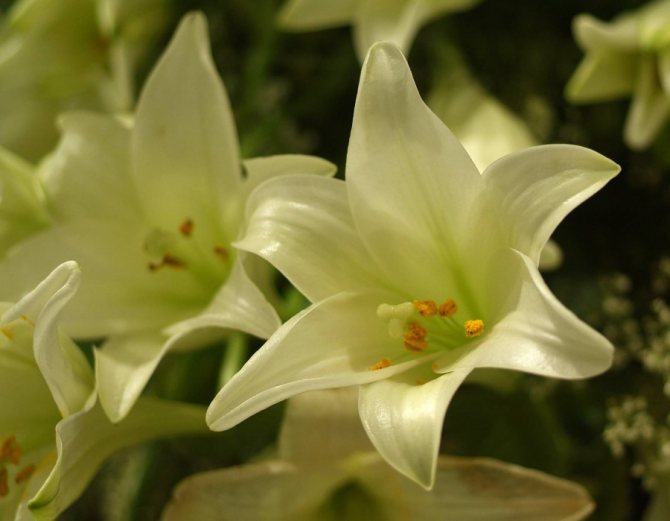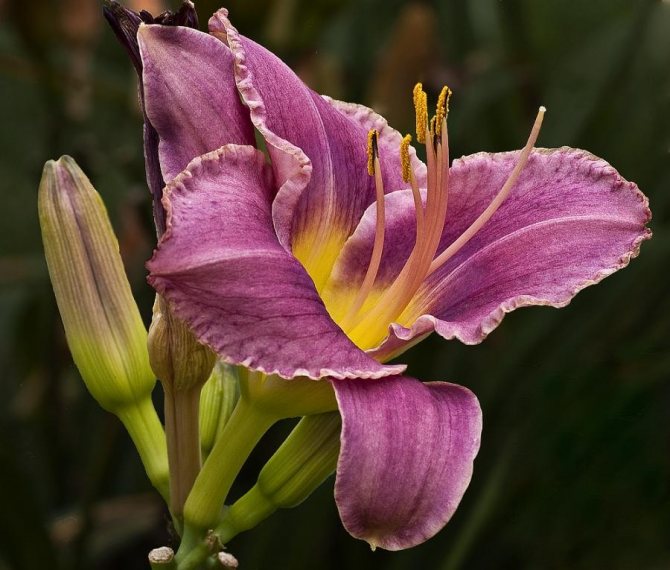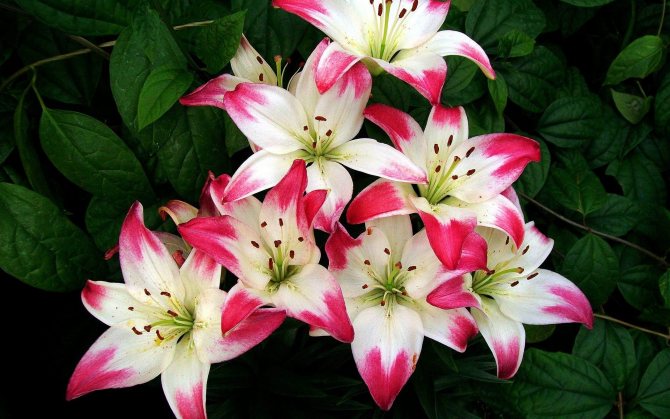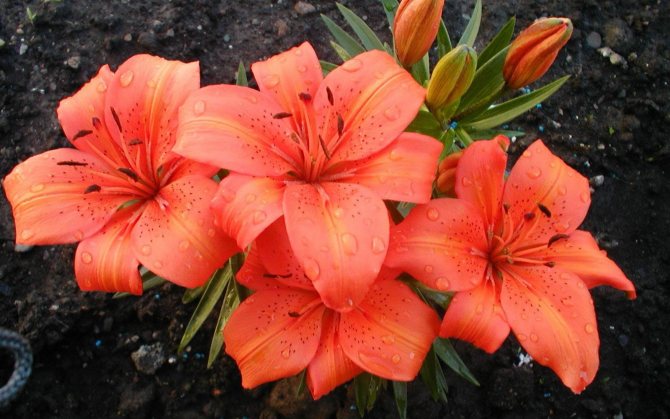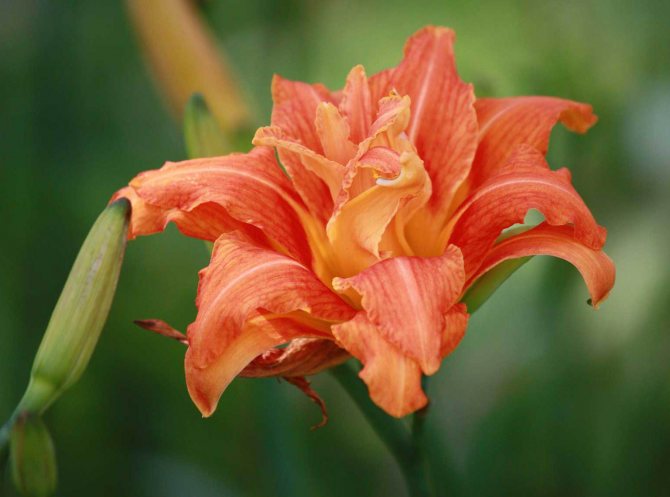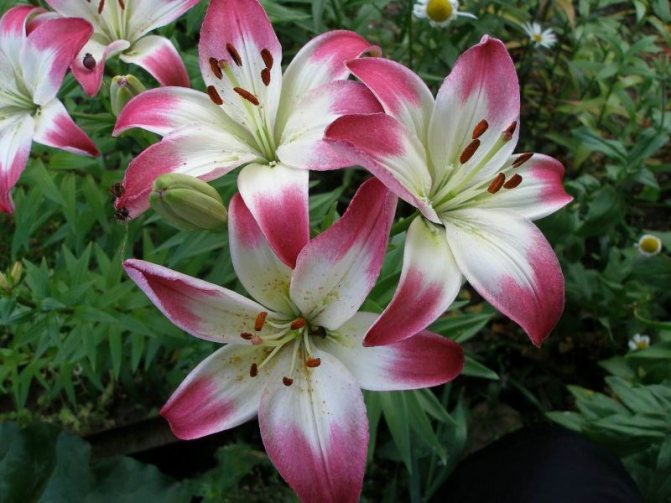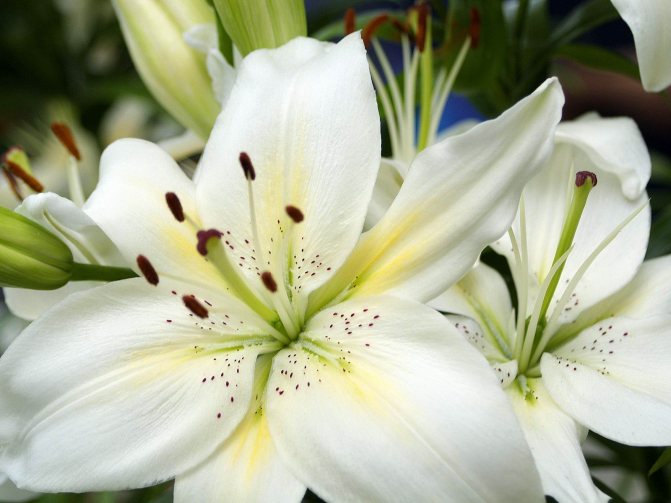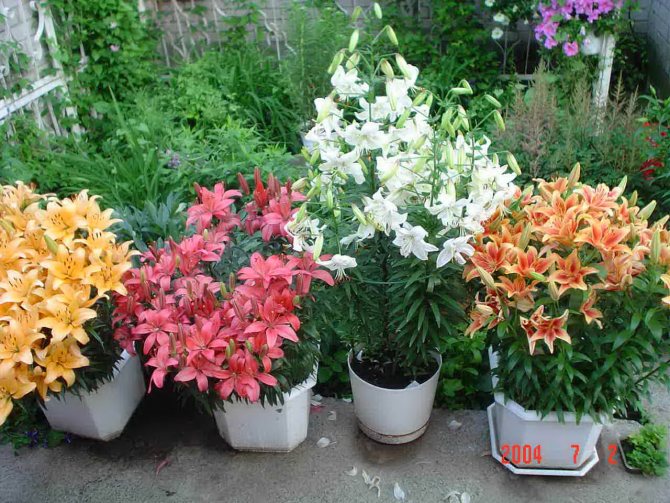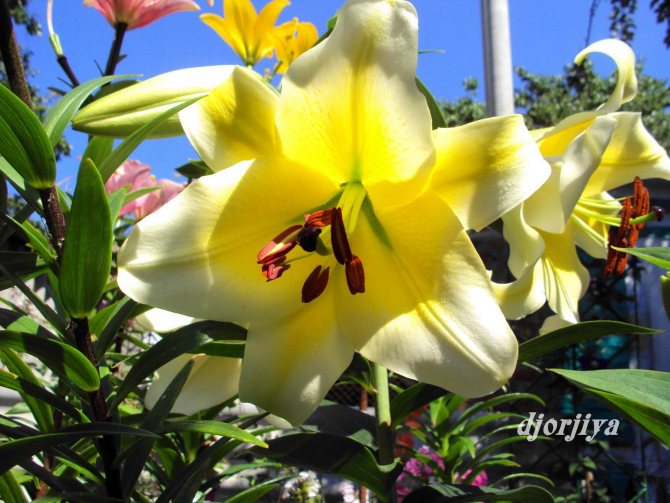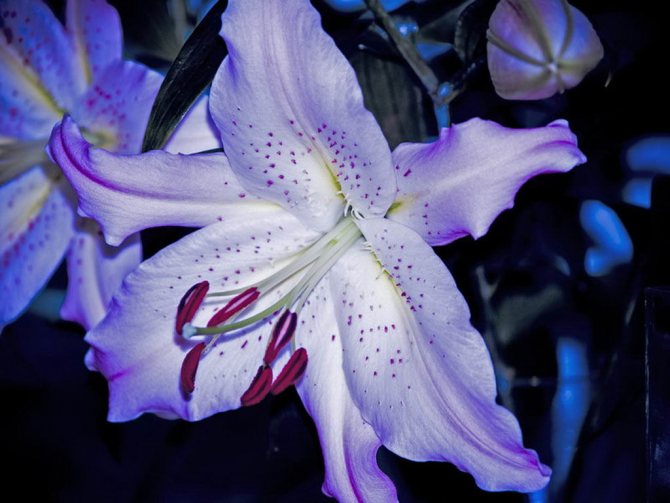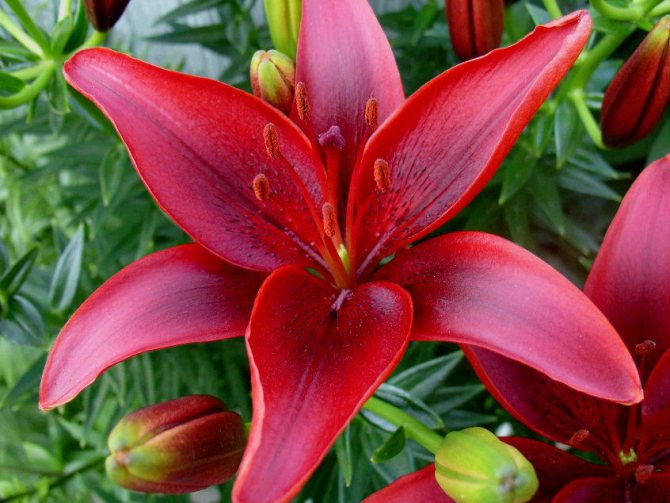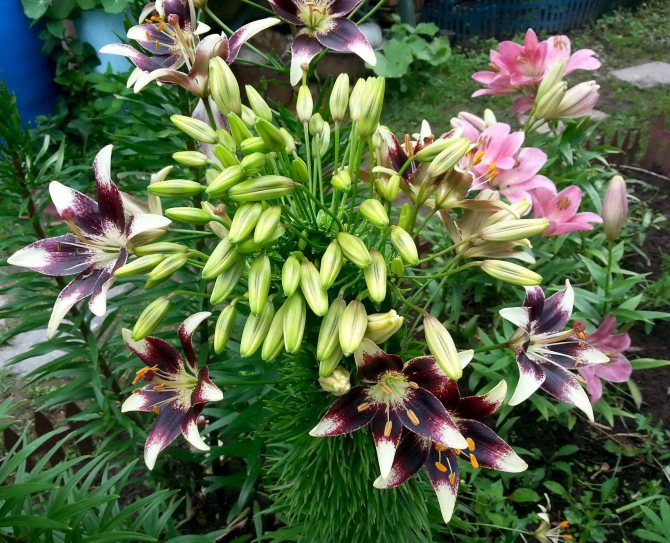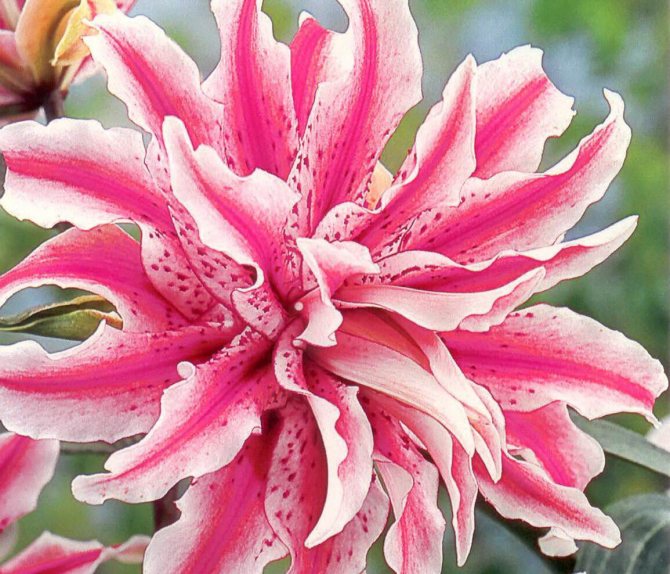Home »Flowers and plants» Flowers »Perennial flowers
Perennial flowers
Vladimir Serchenko
1 comment

Lily, a photo and description of which are presented in our article, is a flowering plant of extraordinary beauty with a pleasant aroma. Since ancient times, the lily has been revered in all cultures. So, in Ancient Greece, it was believed that the snow-white lily flowers are nothing more than drops of milk of Hera - the wife of Zeus.
- Introduction
- What is a lily?
- Varieties
- Asian
- Curly
- Snow white
- American
- Long-flowered
- Tubular
- Eastern
- Most popular varieties
- Marlene
- Red Twin
- Lady Alice
- Purple Prince
- Triumphant
- White Triumph
- Miss Fairy
- Black charm
- Room lily
- Location
- Temperature
- Watering
- Dormant period
- Growing garden lilies and care rules
Varieties of tubular lilies, photos and their description
Tubular lilies are late flowering plants with large flowers and a rich palette of colors. The shape of the bud resembles a gramophone, the petals are dense, the bulbs are fleshy and scaly, the stems are thin, but very strong with narrow elongated leaves.
Every year the number of varieties of pipe lilies is growing, which is confirmed by numerous photos of hybrids of various colors and shapes. To distinguish the most impressive varieties with equally expressive names, you should carefully read their characteristics and descriptions.
African Queen
A plant of dazzling beauty, the stem of which is decorated with 15-20 juicy buds of apricot-orange color with a dark pomegranate strip on the back of the petals. In height, this hybrid is capable of reaching 120-180 cm, the diameter of the flower varies from 15 to 20 cm.
The period of abundant flowering of the "African queen" falls on the second half of the summer. This lily tolerates return frosts with dignity (a temporary drop in temperature below 0 degrees) and develops well even in slightly acidic soil.
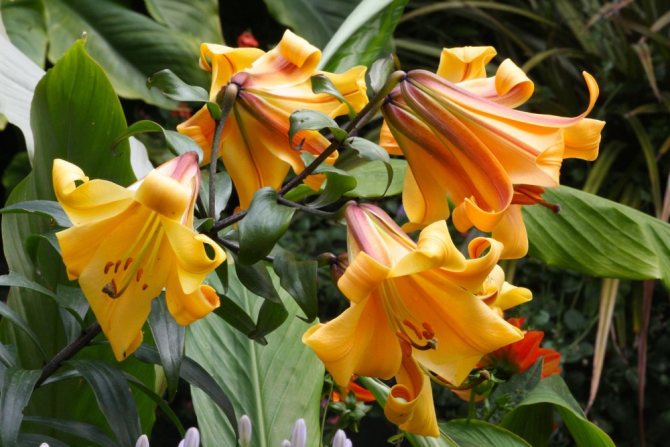

Photo. African Queen Tubular Lilies
Pink Perfection
This plant is ideal for containers, borders and intricate flower gardens. In height, it can stretch to human growth, and in order to enhance the entertainment of this parameter in the garden plot, Pink Perfection lilies are planted in groups of 3-5 bulbs.
On the stem of this tubular lily, up to 12-20 large flowers of a noble dark pink hue are formed. The size of each is from 15 to 25 cm. The blooming period of the pink beauty falls on July-August. A distinctive feature of this plant is its high resistance to fungal diseases.
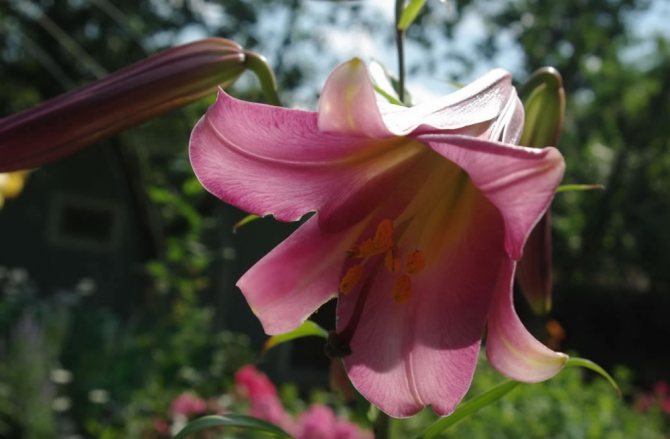

Photo. Tubular Lilies Pink Perfection
Golden Splendor
The name Golden Splendor is translated from English as "golden luxury" and this is not without reason, because the flowers of this tubular lily are endowed with a rich bright yellow color. The plant grows up to 120 cm in height, the flowers are large, can reach 15 cm in diameter.
Representatives of this variety attract with their spicy and overly sweet aroma. They are frost resistant, easy to grow in containers and are great for cutting. The active flowering period lasts from July to August.
Tubular lilies Golden Splendor
White Planets
Another hybrid of a tubular lily of an unusually delicate lilac color.This representative of the plant world can have a whole palette of pastel colors: from lemon yellow to ash pink (with closed buds).
Plant height is about 130 cm. The flowers are large, with a diameter of 10 to 15 cm, directed upwards. It blooms in the middle of summer, has a delicate pleasant aroma. For cultivation, it requires sunny places with partial partial shade, thoroughly ventilated, but protected from strong winds.
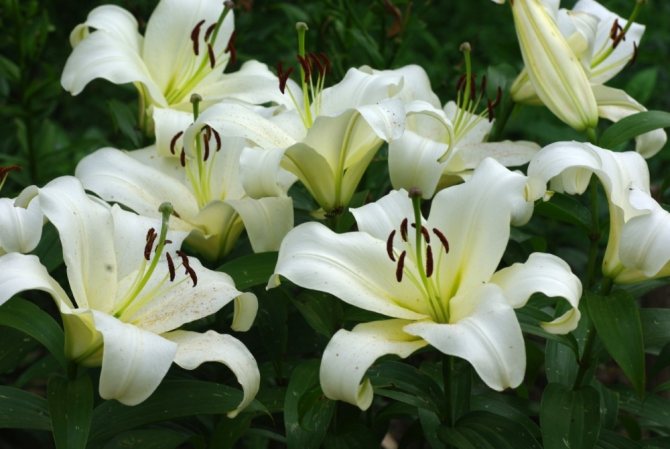

Photo. Tubular Lilies White Planets
Regale
A tall variety of tubular lilies, reaching 180 cm.This graceful plant is forever engraved in memory, thanks to its wonderful smell and unique colors: white flowers on the inside at the base are marked with a wide yellow frame, and on the outside with dark pink stripes.
Flowering peaks in July. The Regale variety is unpretentious in maintenance and requires only a partially shaded place, well-drained soil and regular watering for good development.
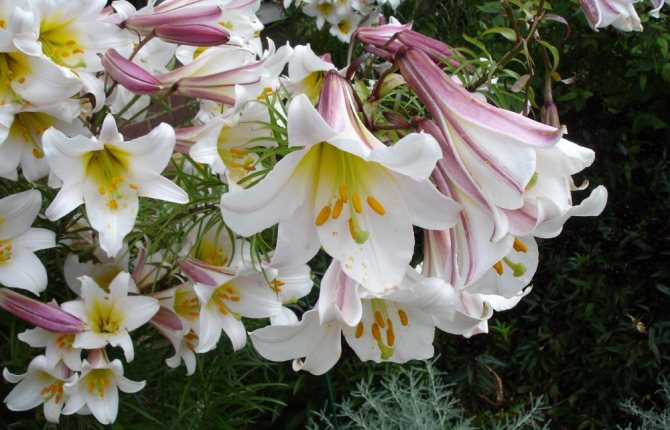

Photo. Regale tubular lilies
Interesting. All pipe lilies are poisonous to cats. To get poisoned, an animal does not need to taste the plant; it is enough to walk next to a fragrant flower. Pollen entering the cat's body causes irreversible kidney damage. There are isolated cases of successful recovery of a poisoned cat, but in most cases the animal dies on the first day.
What is a lily?


It is a garden flowering plant. However, some species are also suitable for indoor growing. It is a perennial culture.
She belongs to the Liliaceae family. It is a bulbous plant, grown by bulbs. There are about 80 different varieties in the genus.
Thanks to breeding work, a wide variety of varietal species and hybrid varieties have been bred.
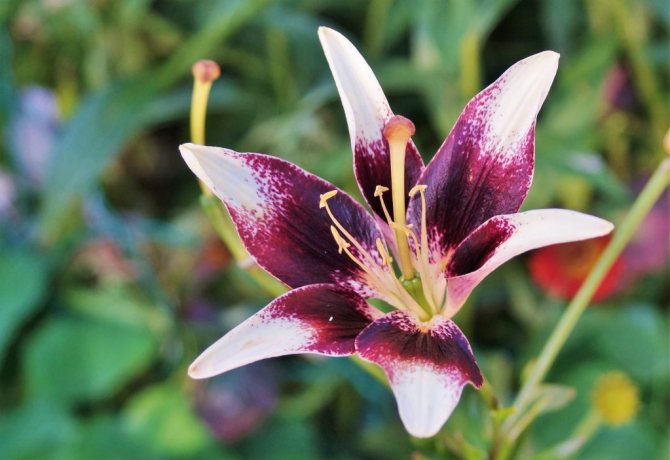

The birthplace of the flower is America, Europe and Asia
The plant got its name rather from the name of the species "white lily", since in the ancient Gaelic language the name of the plant "li-li" is translated as "white-white", despite the fact that in nature there are specimens with flowers of other shades.
Lily is a bulbous perennial plant. Crop bulbs can be of different sizes, from tiny to large (up to 30 cm in diameter).
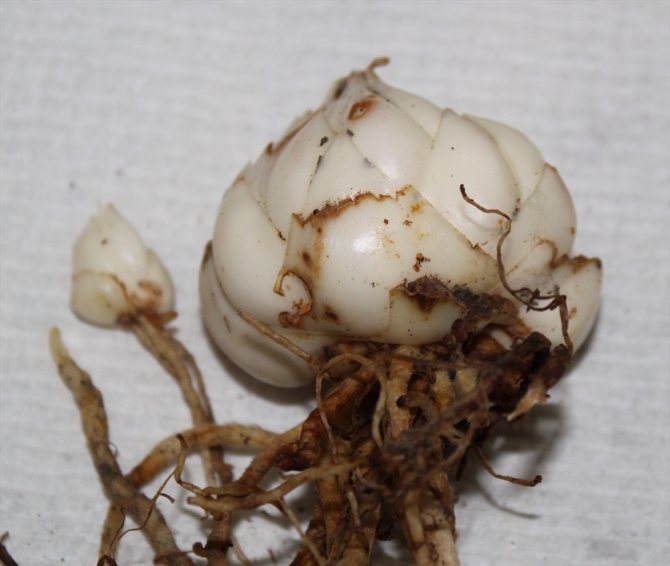

The bulbs are in the shape of a ball or egg. The root growth point is at the bottom, where the scales are attached
The height of the stem depends on the type and variety of the crop.... The stem can be about 15 cm high, can grow up to 250 cm. The stem is leafy, erect.
In some varieties, the leaves can twist in a spiral, while in others they create a root rosette.
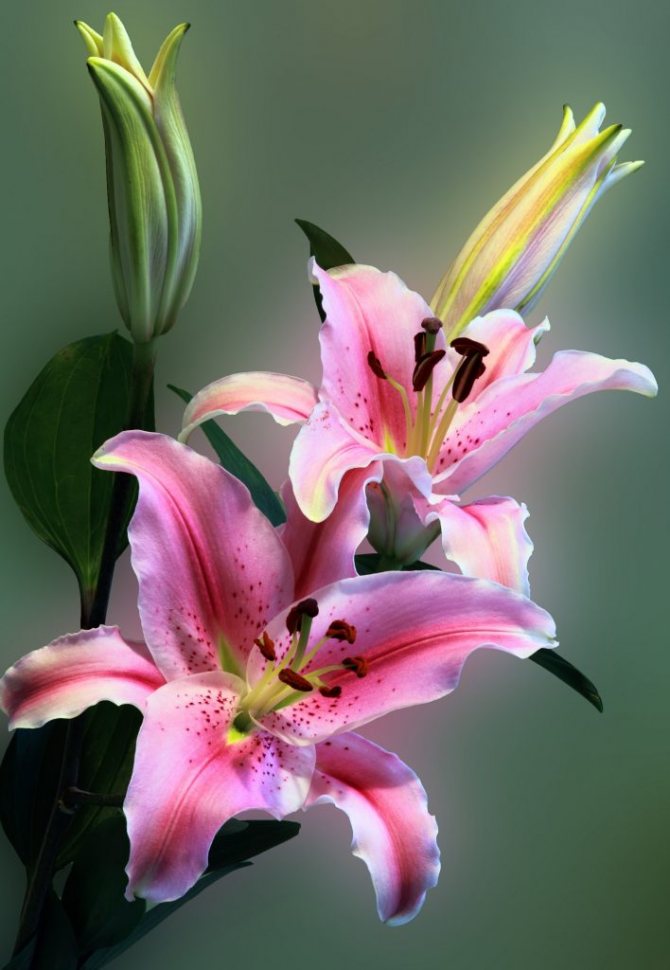

Flowers form inflorescences
The inflorescence can be cylindrical, umbellate and conical in shape. The inflorescence can contain up to 30 flowers, but usually their number does not exceed 15.
The flower usually lives up to 9 days. One flower has six petals, while the flowers of the double variety have more petals than ordinary ones. The shape of the flowers can be different. The size of the flower depends on the shape. If a turban-shaped flower is no more than 10 cm in size, then flat-shaped flowers can reach sizes up to 25 cm.
The color of lilies can be varied: pink, white, yellow, purple, orange, red and others. There are no lilies of blue color.
back to menu ↑
See also: Common heather - honey "frost" in the garden. Description, types and varieties, planting in open ground, reproduction, cultivation and care (55+ Photos & Videos) + Reviews
Flowering tubular lily
For different varieties of tubular lilies, the flowering period does not always fall at the same time. Flowering can occur from June to October. In some cases, it lasts a month, in others - all summer, and in exceptional cases, the process ends only in September.
Unpretentious and beautiful Asian lilies are all about care and cultivation.
Varieties and types of tiger lilies with descriptions and photographs.
Varieties
There are several varieties of lilies. Among them are the following:
back to menu ↑
See also: Phlox - record holders for flowering: description, planting in the open field, reproduction and care (85+ Photos & Videos) + Reviews
Asian
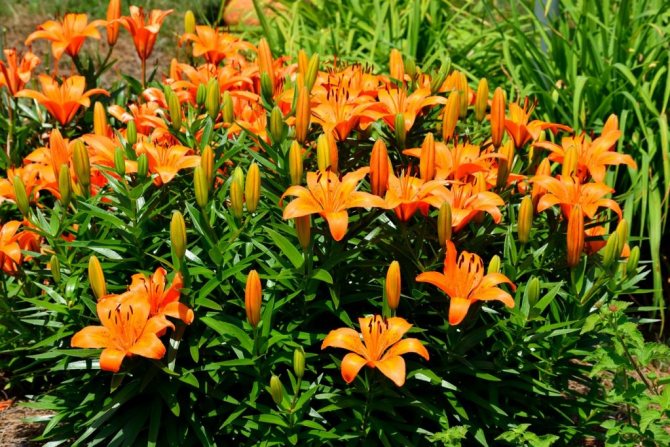

Asian This is an unpretentious kind of culture. Differs in resistance to frost and lack of aroma. There are about 5000 varieties of this species
back to menu ↑
See also: Chubushnik: description of 20 varieties, planting and caring for shrubs in the garden, possible diseases (110+ Photos & Videos) + Reviews
Curly
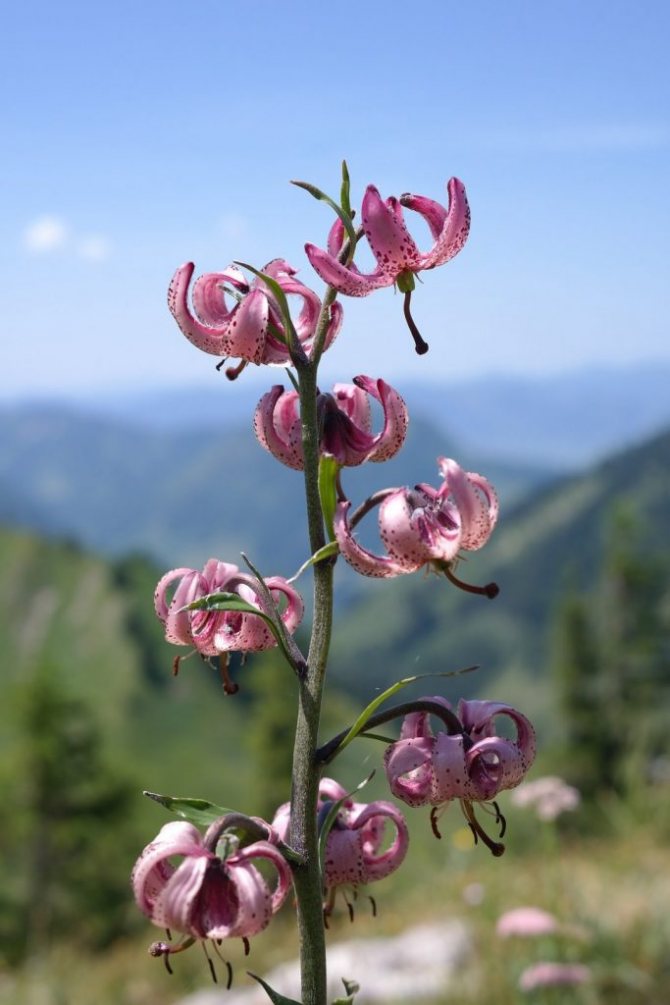

Curly This is a less popular type of culture. The pack got its name from the shape of the flower. About 200 varietal species are known
back to menu ↑
See also: Hydrangea (90+ Photos) - description, outdoor care, reproduction, transplantation, diseases (Video) + Reviews
Snow white
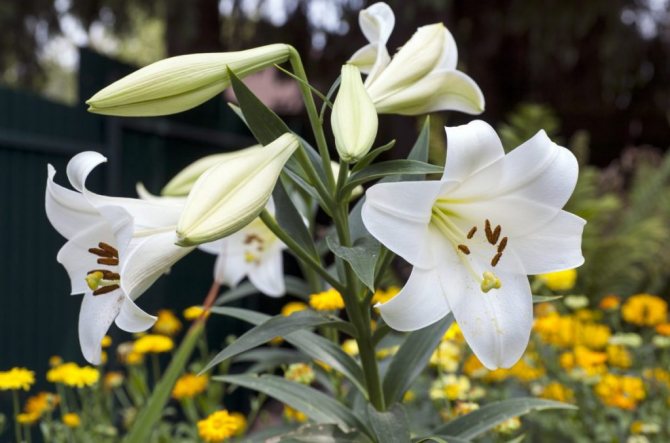

Snow white The most capricious variety of lilies. However, it has an extraordinary aroma of flowers. The flowers are usually snow-white, may have a yellowish tint. The species has about 30 varieties
back to menu ↑
See also: Eustoma (Lisianthus) (100 Photos) - planting and care at home. An extraordinary plant in your garden + Reviews
American
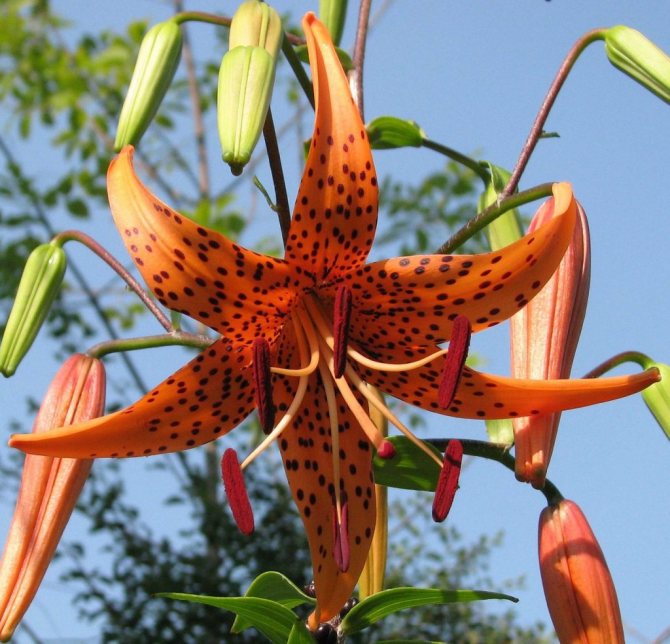

American A popular, colorful variety. The flowers are colorful. Black specks are often found on the petals. The view is rather moody. About 150 varieties are known
back to menu ↑
Read also: Peonies are competitors of roses: description and characteristics of 30 varieties, everything you need to know about them (50 Photos & Videos) + Reviews
Long-flowered
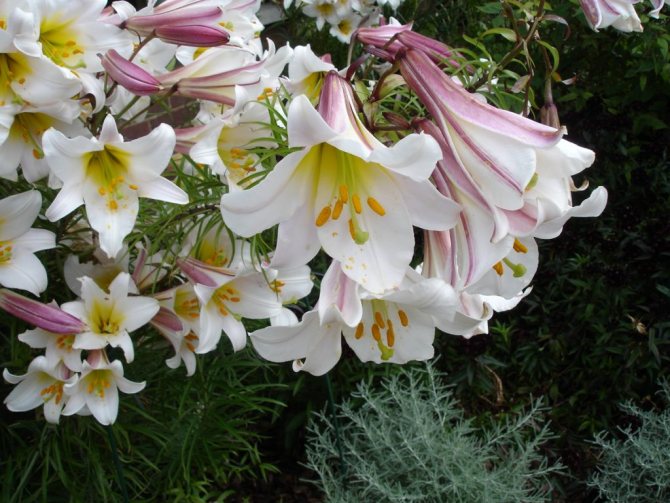

Long-flowered Lily, which is distinguished by an elongated bud shape, hence the name of the species. It has a very pleasant aroma. It is more often grown in greenhouses, since it can suffer from viral diseases in the garden.
back to menu ↑
See also: Rudbeckia: planting and caring for a plant in the open field. Rudbeckia varieties for decorating a personal plot, useful properties (80+ Photo & Video) + Reviews
Tubular
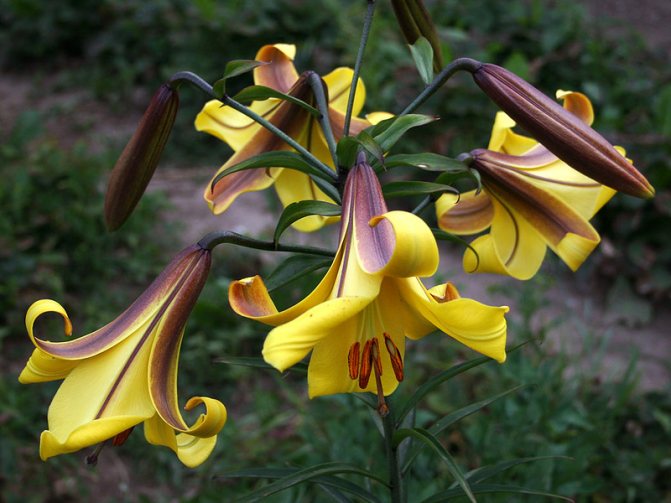

Tubular A very spectacular kind of culture. The flower is shaped like an elongated gramophone. The view is capricious, requires shelter for the winter
back to menu ↑
See also: How to make garden paths in the country with your own hands? (80+ Photo options for great ideas) + Reviews
Eastern
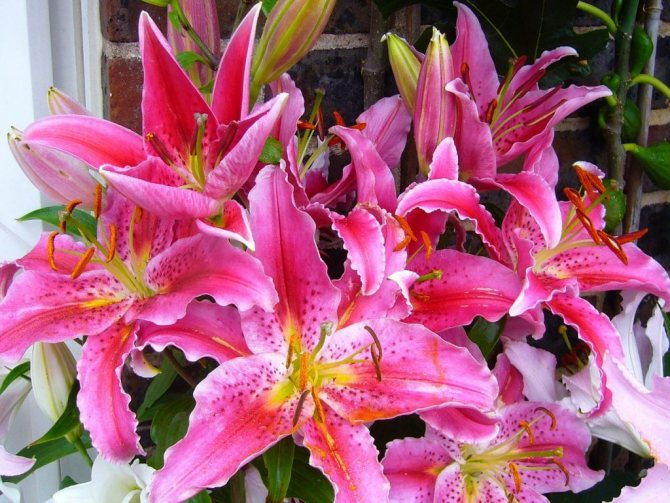

Eastern Quite demanding lily, which does not tolerate cold weather and is often affected by diseases. There are about 1500 varieties of this variety.
In addition, interspecific hybrids and natural species are also known. Interspecific hybrids are the result of the activities of breeders. They are obtained by crossing different groups. They are distinguished by their beauty, large size, unusual colors. Natural species play an important role in breeding new varieties and hybrids.
The most popular interspecific hybrids include:
- Asian - the most unpretentious and most popular hybrids
- Curly lilies or locusts Are hardy varieties that are resistant to frost and intense flowering. The stalk of the locust can reach a height of up to 2 meters. One plant can have up to 25 drooping brightly colored flowers with specks
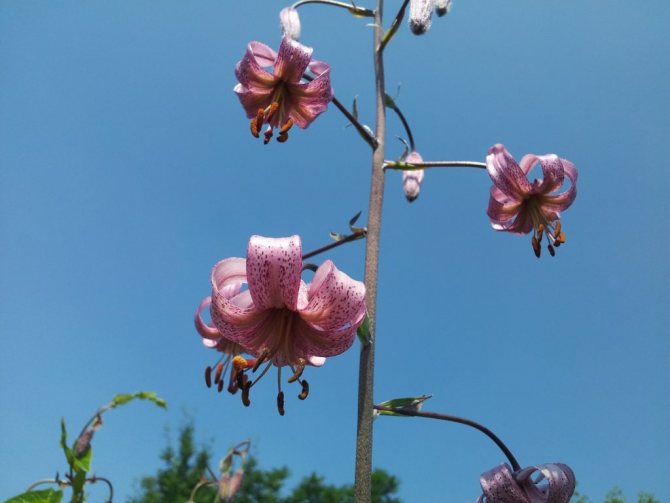

Saranki
- Oriental Are hybrids of incredible beauty. However, they are quite capricious. For the winter, such varieties require mandatory shelter, and in the summer they need fertile soil and an abundance of sunlight.
- LA hybrids Are spectacular varieties with an unusual and beautiful flower shape. The color shades of these lilies are very diverse. The varieties have a pleasant and delicate aroma. Recently, they are very popular among flower growers.
- OT hybrids Are tall plants with large flowers. In addition, they are unpretentious, frost and disease resistant. Therefore, they become very popular
back to menu ↑
See also: How to create beautiful flower beds and flower beds in the country with your own hands? (220 fresh photos and video ideas) + Reviews
Features of the choice of bulbs of tubular lilies
To grow a healthy, strong and beautiful lily, it is necessary to choose the planting material correctly. Bulbs are bought in the fall and planted at the same time. Preference should be given to large, dense, fleshy and sufficiently elastic specimens. For better selection, it is better to probe the bulbs.
Trumpet lily bulbs must be large and resilient.
You should not buy tubular lily bulbs if they:
- excessively dry and hard;
- overly soft with signs of decay or mold;
- too small, less than 3 cm in diameter (as a rule, such material is not viable);
- are in crumpled packaging (it is possible that the bulbs were transported incorrectly, which led to their damage).
Introduction
Jews believe that this flower is the only culture that has preserved its purity and purity after the fall of the first woman on earth - Eve. In Christian culture, the white lily is considered a symbol of the Mother of God.
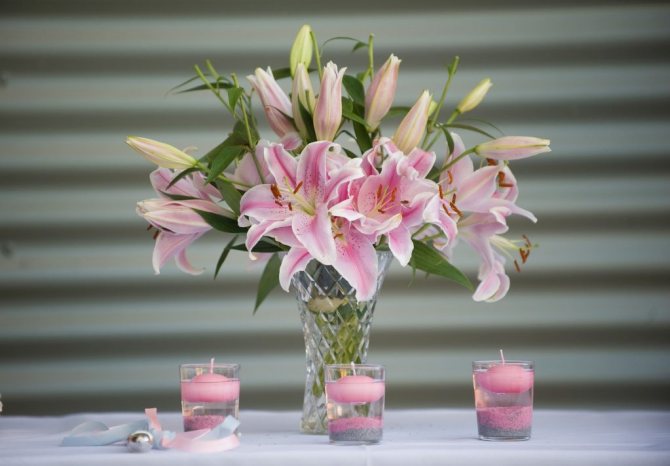

Flower growers love culture for its elegant look and enchanting scent.
You can meet culture not only in personal garden plots, but also in the city - in parks, in flower beds and flower beds. The plant is suitable for various design solutions. However, one should not forget about the rules for growing a plant.
After all, any culture needs attention and care. To grow a beautiful and fragrant beauty, you need to be careful and follow all the necessary rules.
back to menu ↑
See also: Continuous flowering flower bed: garden decoration for all seasons. Flower bed schemes of annual and perennial flowers (85+ Photos & Videos) + Reviews
Features of growing tubular lilies
Growing tubular lilies and caring for them does not require close attention and special skills. However, for the successful growth and development of these bulbs, certain rules must be followed.
The soil
Representatives of the tubular family do not accept acidic, peaty soils in which moisture stagnates. These flowers have long grown on rocky slopes, so rocky soil is ideal. A sandy, calcareous soil with neutral or slightly alkaline acidity works well. If the soil is slightly acidic, it can be neutralized with lime or ash.
Landing site and lighting
The place for growing tubular lilies should be well lit by the sun, because shading leads to poor bud development. Despite its light-loving nature, 5-7 hours of exposure to sunlight is enough for the plant. An open flower garden, not fenced with densely planted trees and tall buildings, would be an excellent place to plant. When grown outdoors, lilies should be planted in an elevated area. The main thing is not to plant these flowers in front of windows, as their persistent intoxicating scent can cause severe headaches. For the same reason, it is irrational to decorate a resting place or a terrace with tubular beauties.
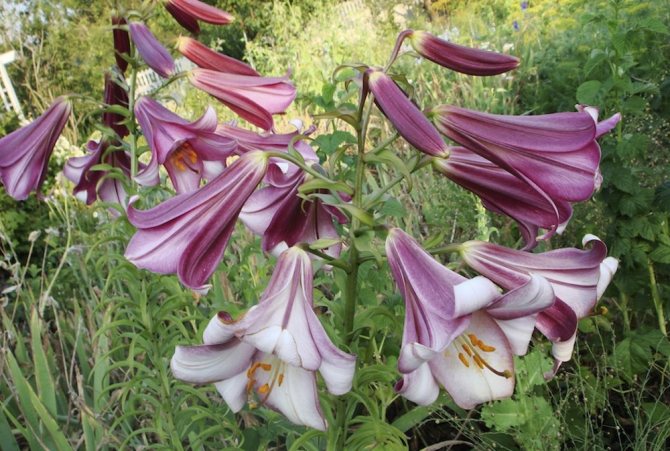

Tubular lilies are planted in sunny areas, but not in front of the windows of a residential building.
Soil preparation
As a rule, lilies are planted in early autumn - before the onset of frost, the bulbs will have time to take root tightly. Until that time, they are stored in a cool place in peat or coarse sand.
To prepare the soil in which the plant will be planted, sandy soil with humus, fine gravel and gravel in a ratio of 4: 1: 1 is used. This mixture must be diluted with 2-3 parts of nitrogen-containing fertilizer in the form of peat and compost mixed with soil. The last step is to add ash (limestone) to the mixture.
Planting lilies
Planting a tubular lily is carried out in the following order:
- the bulbs are treated in advance with a weak solution of potassium permanganate;
- a hole is dug up to a depth of 35 cm;
- prepared soil is poured into the hole until the desired planting depth of the bulb is formed (tubular lilies are planted to a depth equal to the diameter of the bulb multiplied by three);
- the bulb is placed in a hole, after which it is sprinkled on top with a layer of prepared soil;
- after that, the earth is watered with cool water, mulched with leaves and peat chips.
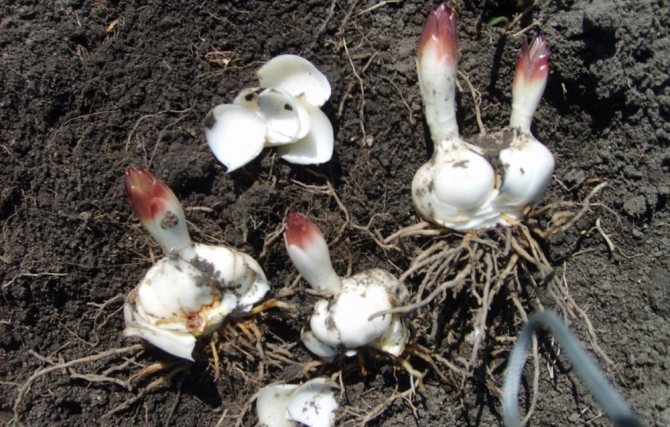

Tubular lily bulbs are pretreated with manganese.
The distance between plants must be at least 15 cm.
Attention. One of the reasons for the delayed flowering of the tubular lily is too deep planting.
Location
Where to put the eucharis pot? Any window sill will do, even on the north side. Eucharis can take up a lot of space due to its large size.
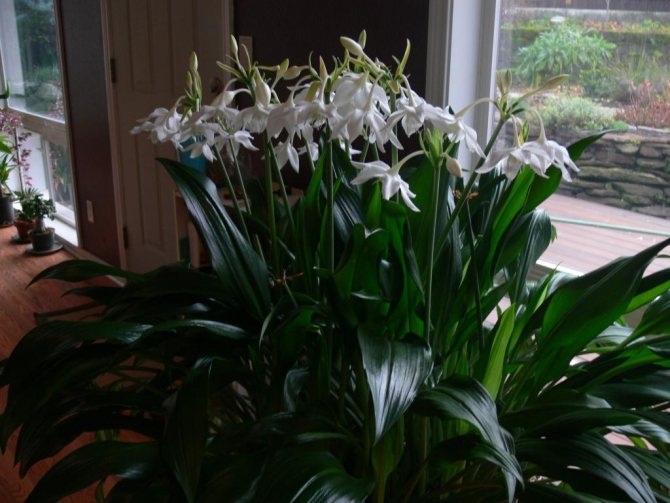

Eucharis - on the windowsill
However, it is impossible to say that the plant is unpretentious to the sun. If the culture is on the north window, then it is advisable to place the pot as close to the window as possible. However, direct sunlight is undesirable for eucharis.
back to menu ↑
See also: Perennial asters: description of 13 species, care and planting at home, methods of reproduction and growing from seeds + Reviews
Necessary care
The first time after planting, lilies do not need care and feeding. But with each summer, their stems are filled with strength, become powerful and long, flowering increases, which means that more careful care is needed.
In the spring, after the ascent of the sprouts, the plant must be fed with nitrogen-containing fertilizers of organic origin, which include compost and humus. When the temperature drops below -3 degrees, the flowers must be covered with a cloth. At higher temperatures, you should not show excessive guardianship - in this way the lilies are hardened and become strong.
In the summer, flowering buds develop, which indicates an increased demand for mineral and organic nitrogen fertilizers. In July, you can mulch the soil with straw, hay - this will help suppress the growth of weeds and retain moisture in the soil. Watering the plant during a sultry summer is enough 2-3 times a week, in moderation. After the plant has faded, it is necessary to remove the fruit pods, which "steal" nutrients from the stem.
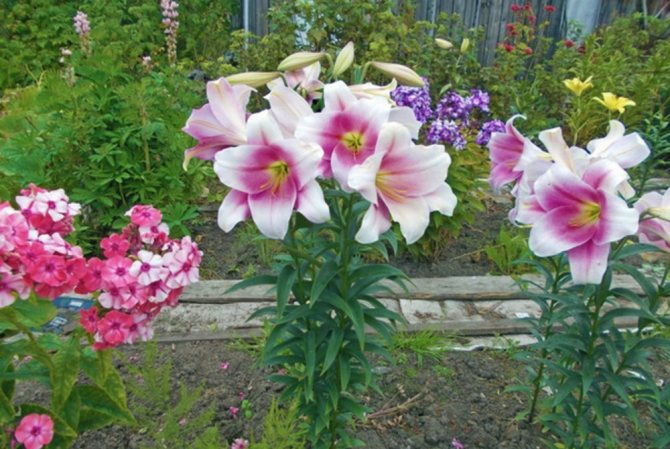

Tubular lilies are watered about 2-3 times a week, provided that the summer is very hot.
During the autumn torrential rains, the aboveground components of the lily are cut at the very edge of the earth, and the plant itself is fed with ash to improve its frost-resistant qualities. The rest of the tubular queen is covered with a waterproof material: film or foamed polyethylene. One plant requires 1 sq. meter of such a shelter.
Temperature
The average summer temperature should be around 20 degrees. The plant feels comfortable at this temperature. It is not recommended to lower the temperature in summer to 17 degrees. In winter, it is recommended, on the contrary, to lower the temperature to 16 degrees, but not below 14 degrees.
Large fluctuations in temperature can result in small flowers.
back to menu ↑
See also: Raspberries: how to care for them to have a good harvest? In spring, summer, autumn and winter: features of watering, feeding, pruning shrubs and its remontant varieties
Protection against diseases and pests
The plant has an average resistance to pests and various diseases. It can be affected by lily rattles, spider mites, mealybugs, voles, scale insects, etc.
The best protection against pests will be an infusion of wormwood:
- 1/3 of a bucket of ground wormwood is steamed with boiling water, a glass of wood ash, 1 piece of laundry soap and 100 g of sulfur are added there;
- the infusion is kept for 8 hours, after which it is filtered.
It is better to spray the plant in the evening, for this you need to dilute half a glass of infusion in a bucket of water.
Tubular lilies can suffer from fungal diseases, fusarium, gray rot, and other unpleasant ailments. For prevention purposes, plants are treated with a dark pink solution of potassium permanganate or fungicides: Bordeaux liquid, formalin, sulfur color, etc.
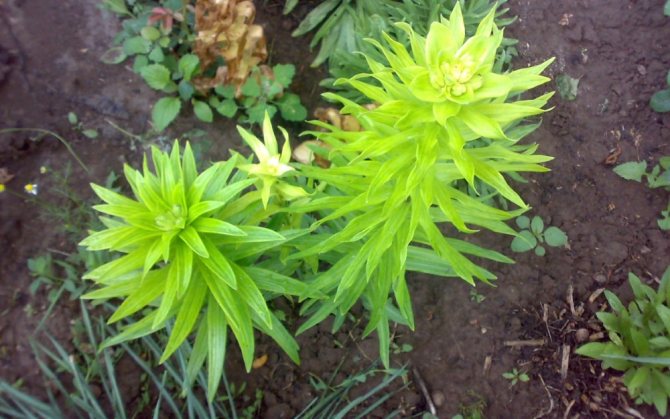

If spots or plaque appear on the lily leaves, measures should be taken and the plant treated.
What types of onions can be planted in summer?
It is using this technology that the most delicious onions and Japanese hybrid onions are grown. But it is not worth limiting the range of onions that can be grown using this technology only with them, because both the Dutch onion sets and German varieties are excellent. The earliest harvest allows us to get the Weisse Koeningin variety and its little-known competitor Weisse Fruhlingszwiebel, whose main trump card is often called its high winter hardiness. But you can truly appreciate the benefits of this variety only with summer sowing, the onion harvest will indeed be ready for harvesting surprisingly early. Such varieties as “Senshyu Yellow”, “Keep Well”, “Elody” are not inferior to him in taste. But you can choose any onion suitable for winter crops with high resistance to cold.
Preparing for winter
On the eve of winter, the aerial parts of tubular lilies are cut at a distance of 1-3 cm from the ground. Thanks to this manipulation, the bulb will sooner go to rest, and in the spring it will easily acquire new foliage.
The rest of the plant is covered with a waterproof material, such as a film or polyethylene, which will protect against heavy rainfall in the form of rain in autumn and snowfall in winter. Spunbond, lutrasil or burlap are not suitable as a covering material, since they allow moisture to pass through, which bulbous plants do not like very much.
Watering
Watering is the most important point in plant care. It should be rare and not too abundant. Watering eucharis is required only when the soil is completely dry.
Stagnant water is extremely dangerous for plant roots and can cause rotting.... This is fraught with the death of the entire plant.
It is better to dry eucharis than to pour. It is much more difficult to save culture from overflow.
back to menu ↑
Read also: Periwinkle: description of the main species, recommendations for care and reproduction, medicinal properties (50+ Photos & Videos) + Reviews
Post-flowering care
After the end of flowering, the peduncles are carefully cut off.
In the period after flowering, lilies need to be treated with special care. In no case should you cut off the stems and leaves, because after that the bulb stops growing and stops developing. Even withered leaves and stems nourish the bulb with nutrients. It is also not advisable to remove annual roots located at the very ground level.
Lilies need regular feeding even after they have bloomed. It is better to use potassium-phosphorus complexes and organics (not fresh) as fertilizers. Mineral mixtures should be discarded, because they give only a short-term effect.
When to plant "winter" onions?
The sowing time for winter onions is very limited. It is possible to sow this onion, the first in terms of yield, only from mid-July to early August. Most often, the sowing interval is limited to the period from July 15 to August 10.


Early spring bow. <>
Storing the bulbs
At home, before planting in the ground, the bulbs can be stored in the following ways:
- In a refrigerator. The material is pre-wrapped in bags with wet moss or peat.
- In the basement or cellar. In these places, the temperature is unstable, therefore there is a risk of premature growth or deterioration of the material.
- Planting in pots - a forced method used in case of germination. The bulbs planted in pots are stored in a bright, cool place.
Important. Lilies stored according to the third method most likely will not bloom in the coming summer.
Reproduction
The easiest way to propagate is by bulbs. Lilies are propagated in the fall. But you can propagate plants in the spring. The bulbs will start blooming in the year of planting.
It is interesting! According to one of the legends, an elf lives in every pipe lily.
Another way is the reproduction of bulbs by children. It is often used by experienced florists. The babies are separated from the main bulb and planted in the ground. Bulbous babies usually bloom next year.
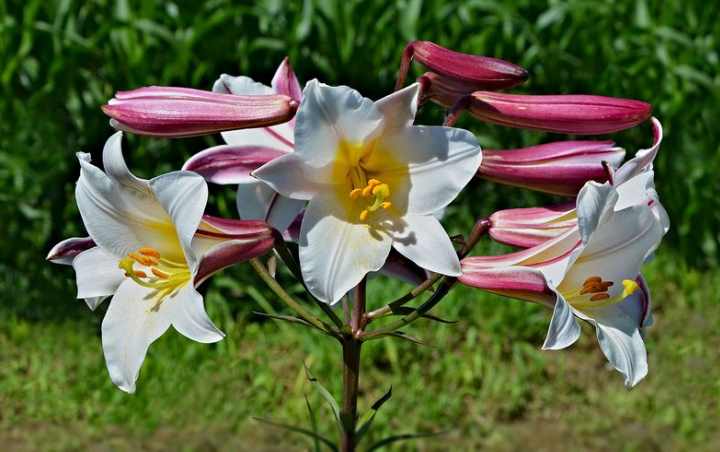

Use in landscaping and in combination with other colors
In landscaping, tubular beauties are the dominant accent of any flower bed. They go well with small-colored phlox, tradescantia, astilbe of an identical shade, yarrow, burnet, thuja and mock-orange.
The best are the compositions where lilies and chamomiles, asters and gladioli are planted in the center of the flower bed, and other bulbous plants are scattered along the border. The joint planting of lilies with alissum, marigolds and garden carnations, which perfectly set off the brightness of lilies, looks no less beautiful.


Tubular lilies are combined with many garden flowers.
When creating a flower arrangement with tubular lilies, you should know that yellow lilies go well with a blue monard, orange with a blue delphinium and white hydrangea, and light-colored flowers look elegant surrounded by maroon barberry.
Cons and pros of a flower
Among the advantages of the tubular lily of the varieties discussed above, it is worth noting:
- strong immunity;
- high frost resistance only in adult plants;
- high adaptive qualities;
- ease of reproduction.
The disadvantages include:
- low frost resistance;
- the need to shelter or dig up young seedlings for the winter.
Summing up, it is worth noting that the main features of the tubular lily and its varieties are described in detail, by which it is easy to distinguish the considered species from other representatives of Liliaceae.
Planting Candidum lilies.
After flowering, the stem of the flower dries up rather quickly, and in July-August the plant retires. It is at this time that it is best to transplant it, because in September the bulb releases a root rosette of leaves, from which it leaves for the winter.
This is a very important stage in the development of a lily. For the lily to bloom well, the rosette must form strong and the lily must take root well.
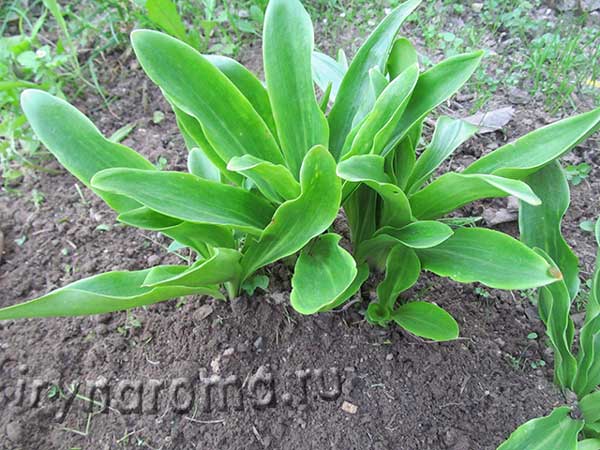

The transplant is best done quickly, without allowing the roots to dry out. This lily loves the land of loamy, well-fertilized and drained soil, so that the water near the roots does not stagnate. However, all lilies love it. When planting, well-decomposed manure or humus can be introduced into the soil. In no case should fresh manure be put.
Lilia candidum is quite picky about the choice of location. She wandered from place to place with me several times, until she liked the place more or less. When planting, it will be nice if there is light shading at lunchtime or in the afternoon.
Lily does not like acidic soil very much, it develops poorly on it and is sick. Reacts well to liming of the soil, and even transfers lime in the soil.
Before planting, you should carefully prepare the soil - dig well and deeply and carefully select the roots of perennial weeds, because Candidum does not like frequent transplants.
Planting is best done at the end of August, before the leaves begin to show. Planting should be shallow, there should be 3-4 cm of soil above the top of the bulb. On light soils, they are planted deeper, on heavy soils - shallower.
The main international classification of lilies
At the end of the last century, the total number of lily varieties obtained from crossing various species and hybrids with each other reached 10 thousand and every year increases by several hundred varieties.Since lilies are quite different in terms of care requirements and in other characteristics, then in the middle of the 20th century, a single international classification was adopted, which, with minor changes, has survived to our time.
According to this classification, among the lilies, it is customary to distinguish the following 10 sections:
- Asian hybrids.
- Curly (Martagon).
- Snow white (Candidum).
- American (American).
- Longiflorum (Longiflorum).
- Trumpet and Aurelian
- Oriental.
- Interspecific hybrids (hybrids between the varieties of the previous sections, named after the first letters of their Latin names, LA-, OT-, LO-, OA-).
- All wild species.
- Hybrids not included in the previous sections.
Florists are creative people and often come up with their own color classifications. So often you can find the classification of lilies according to the color of flowers, according to the height of the stems, according to the structure of the flower (double or not), according to the presence or absence of aroma, according to winter hardiness, according to the methods of reproduction. All these features will be surely considered in the description of the groups and varieties of lilies below, with the obligatory names of varieties and photos.
How to plant
It is necessary to prepare for sowing in advance, not less than a month in advance. Fertilizer is placed in a shallow hole 30-40 cm dug. For these purposes, manure or compost is used in the volume of a 10-liter bucket. Make sure they are rotten, otherwise the root system may rot.
Then a couple of tablespoons of superphosphate are poured out. As a result, everything is poured with a solution of wood ash. Please note that if you are working with a candidate or martagon, then exclude this component.
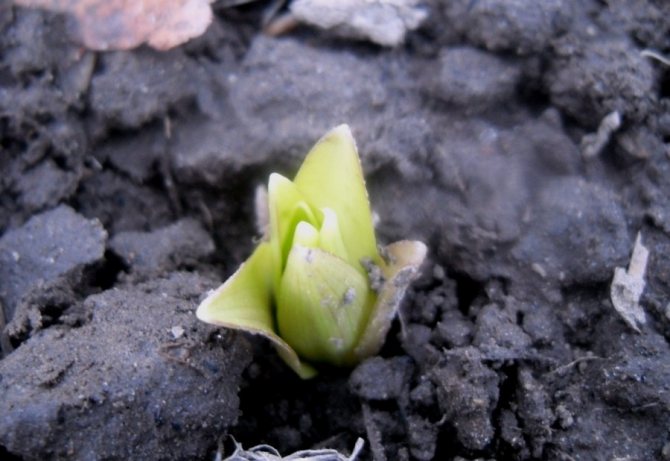

When preparing the bulb for planting, remove the dead roots from it, and then rinse. If it is dry, then it can be soaked in warm water for a short time.
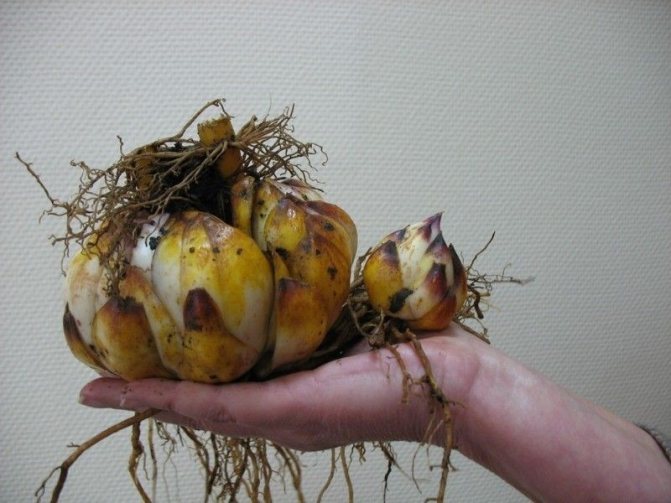

Immediately before the procedure, soak it in a specially prepared liquid:
- potassium permanganate;
- a drug for etching (Vitaros, Maxim);
- foundationol or karbofos.
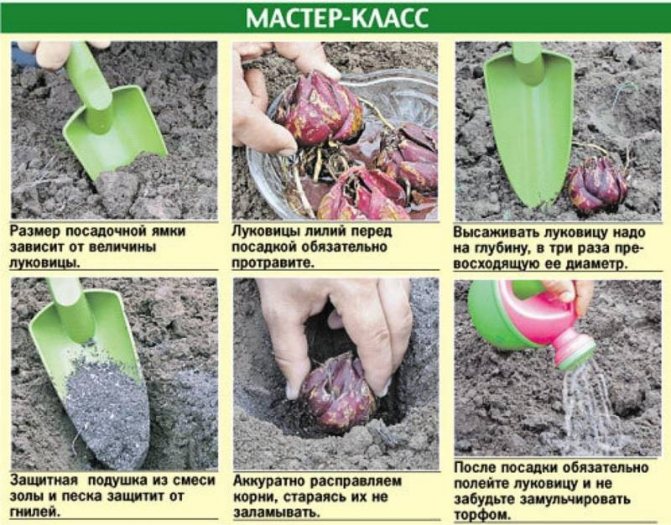

Application in traditional medicine
Possessing an analgesic effect, drugs based on candidum eliminate pain of various origins, including smut and joint pains. By blocking nerve impulses, pains caused by inflammatory processes are also eliminated.
Otitis of various stages is also quickly treatable with flower-based preparations.
White lily copes with diseases of the respiratory system, including inflammatory ones.
Due to the vaso-strengthening properties, the snow-white lily is able to help patients with atherosclerosis.
Flower-based tinctures and oils have a wound healing effect and are used in the treatment of burns, boils, purulent wounds and ulcers.
American hybrids
The varieties of this species are very tall (up to 2 meters), they love partial shade and do not tolerate transplanting. A slightly acidic soil with good drainage is suitable for them. Even loamy soil will do. American hybrids tolerate drought well.
Flowers of the Lake Tular variety are very bright, the stem height reaches 120 cm.
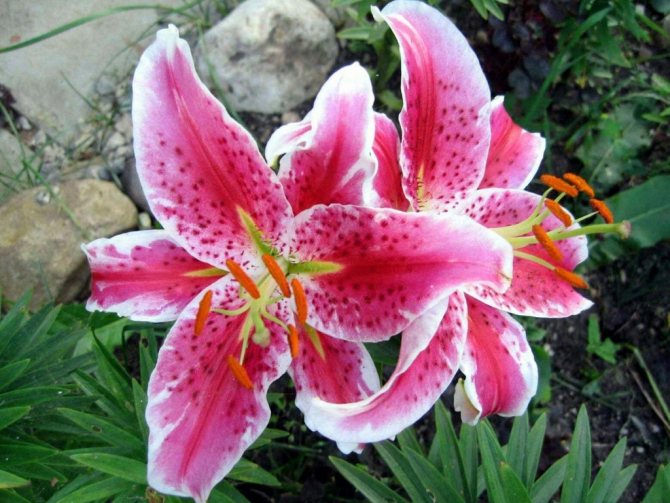

The Afterglow variety is distinguished by its turbid, bright flowers and a high stem up to 2 meters.
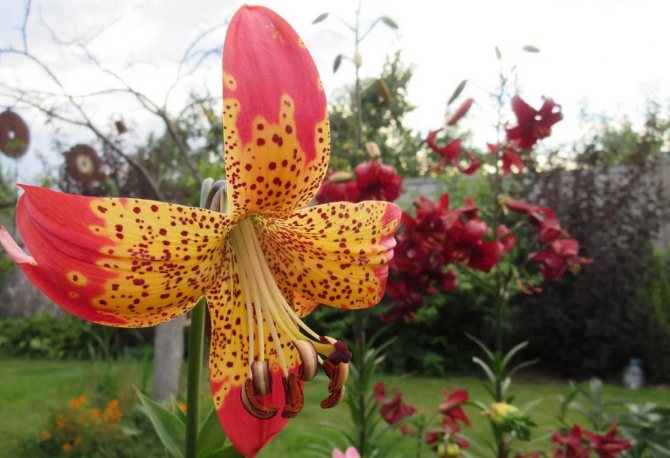

Recent Entries
Gardener's lunar calendar for 2020: we do it right 3 reasons, make a reservoir in the country: we plan a new season Note for gardeners: 7 useful things to save energy
The Shaksan variety is very easy to care for, has a pleasant aroma.
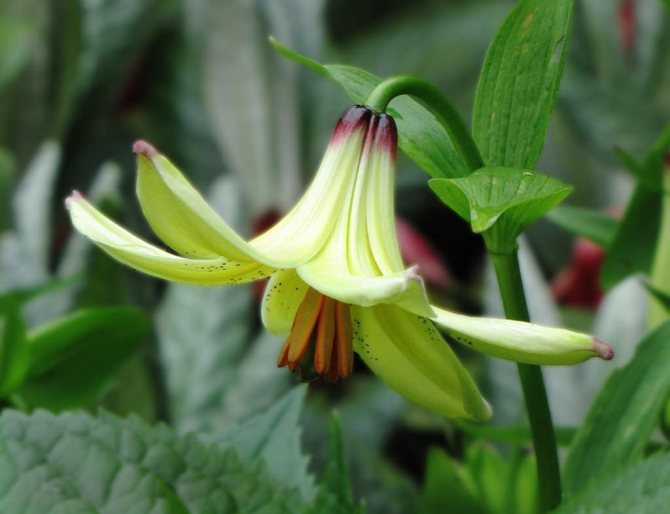

Snow white hybrids
These hybrids are also called European because of their origin from species bred in Europe. Lilies are usually tall (up to 190 cm) and have a strong aroma. They prefer planting on the sunny side, they are often affected by a fungus, therefore, careful care and treatment with special preparations is required.
The Apollo variety is undersized, 80–100 cm tall, fragrant flowers, up to 10–12 cm in diameter.
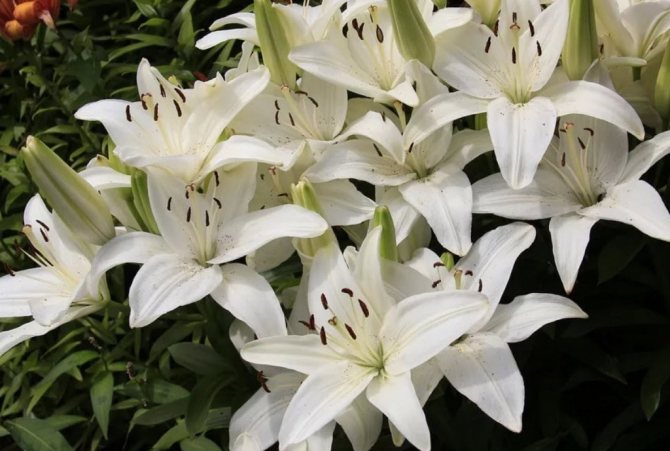

The Madonna variety blooms in June, the buds reach 13 cm.The bush blooms profusely and smells good.
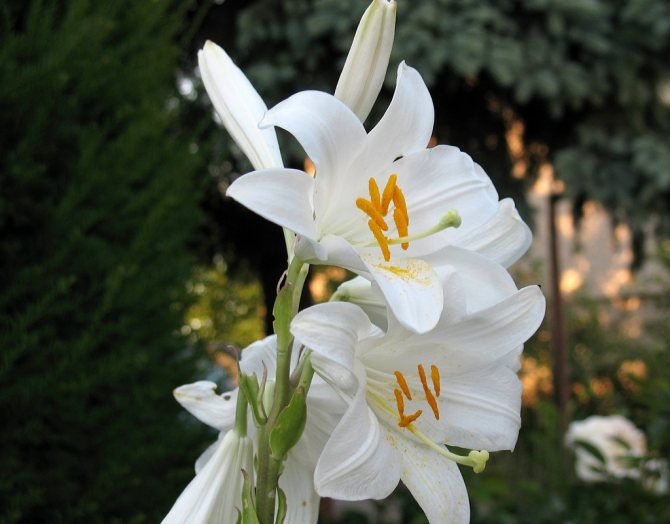

White lily diseases
Typical plant diseases: Snow-white lily suffers from many different diseases, more precisely, they number in dozens: aphids - lily and greenhouse, thrips, lily fly, purple scoop, onion hoverfly, onion leaf beetle, stem clickers, root onion mite and gall nematodes and gall nematodes and nematodes Lily white most often with various rot. In order to prevent rotting, it is necessary to monitor the humidity. Water should not stagnate under the flower, and the place should be freely ventilated.
Tips for growing lilies and other garden flowers
Gallery
Tree lily plants
Naturally, these are not trees. These lilies do not have a trunk, which is woody, and in the southern regions they generally die in the winter season. So why then tree-like? They are connected with a tree only by enormous growth, which flowers do not have. In the Ural and Moscow region, plants may not grow to 2.5 m, even if you take care of them too much. Flowers can reach this height only in the south of our homeland. In middle latitudes, lilies grow up to 1.5-1.7 m, which is also very good.
Moreover, special agricultural technology is not needed, and plus the plants have excellent winter tolerance. Some tubular varieties can also grow to the size of a giant.
Varieties: Debbie, Labrador, Manissa, Purple Prince, Sucinto, Empoli.
Blue varieties
What can I say - there are no such varieties. This is all a marketing ploy of unscrupulous sellers, they simply process photos of lilies in programs to get them blue. But do not be upset: craftsmen from Japan, as always, will save the day - they promised to show the world blue lilies by 2020.
In conclusion, it is worth saying that in no material that is given to you, or that you find on your own, no one will convey the descriptive characteristics of lilies and their aromas as accurately and clearly as you do. Just plant these flowers and experience it in practice. But, I think, our article will be useful to you in choosing a variety. Thanks for attention!
Lily varieties
Amazonian or Eucharis
The bud opens 10 cm wide, just a couple of times a year with a rational and balanced content. It will become an elegant decoration element.
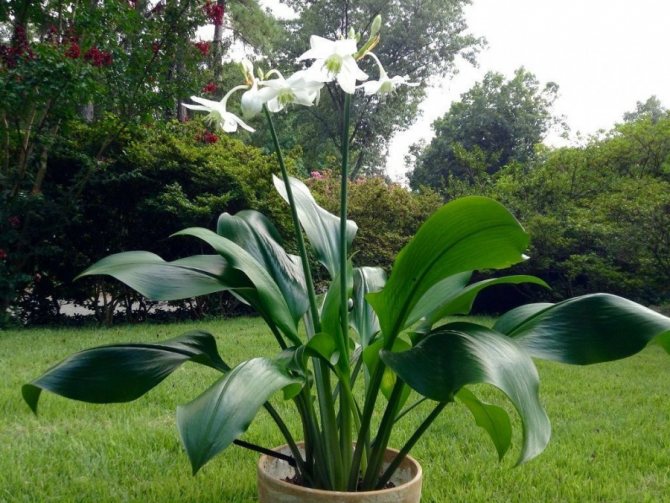

It is placed on a windowsill, preferably on the north side. The optimum temperature is 18-22 degrees. Over-watering can cause rot, so water less frequently and in small amounts.
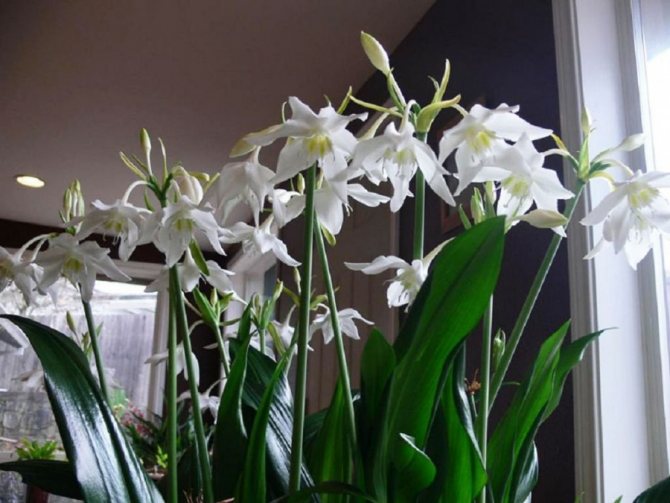

Based on an overview of the varieties of lilies, with photos and names, you can, with the simplicity inherent in competent gardeners, navigate the choice, based on specific nuances.
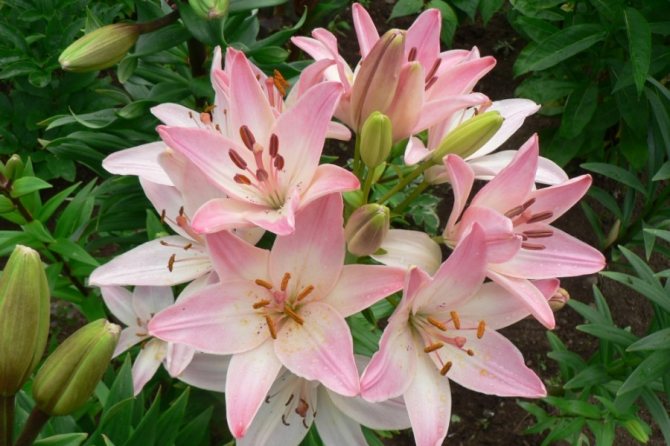

To enjoy the beauty throughout the season - purchase the most diverse, based on existing reviews, and they will be gradually replaced, pleasing your eye.
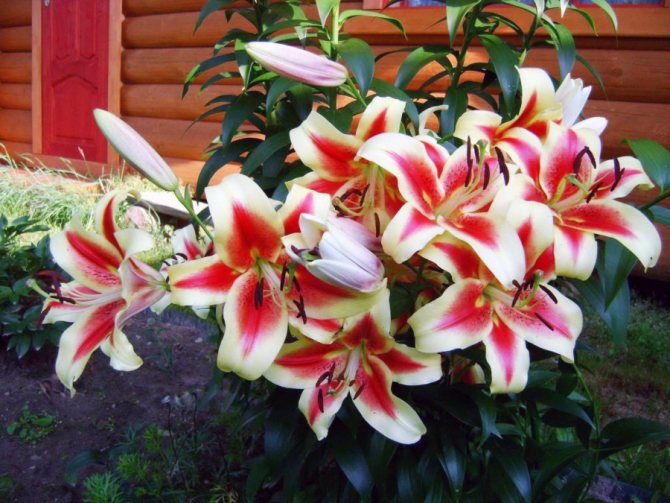

How to care
We must not forget that we are talking about a perennial plant, so it is imperative to think in advance how to plant and what features to take into account: illumination, irrigation and feeding with minerals.


Choose a sunny area. It will not be superfluous to be able to shade the bottom - this will have a beneficial effect on the base, since it will be protected from overheating.
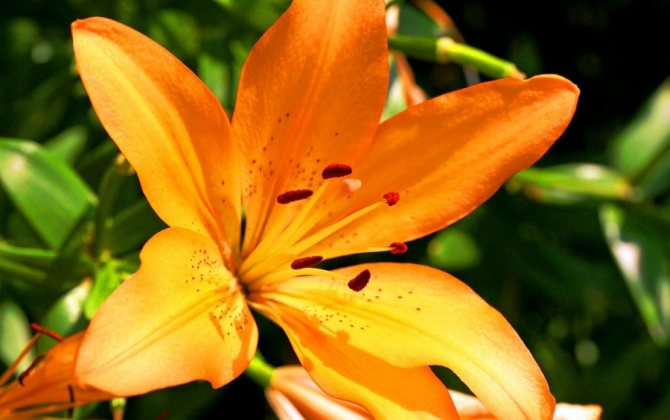

Undersized bells and hostas are used as shading. Thanks to this neighborhood, you will also protect the lower part from overdrying.
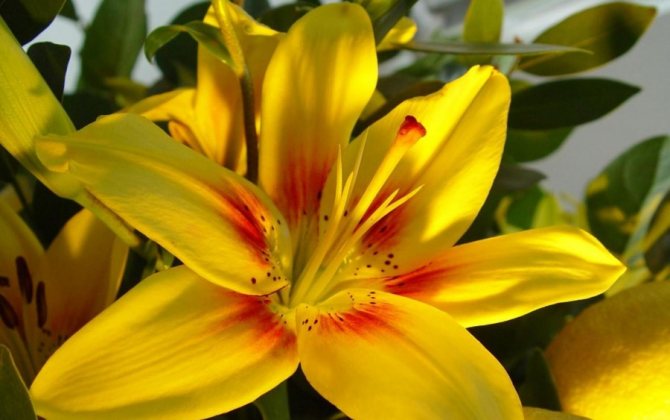

Sawdust is an alternative. Move the beauty away from the trees, which take away nutrients and create thick shade.
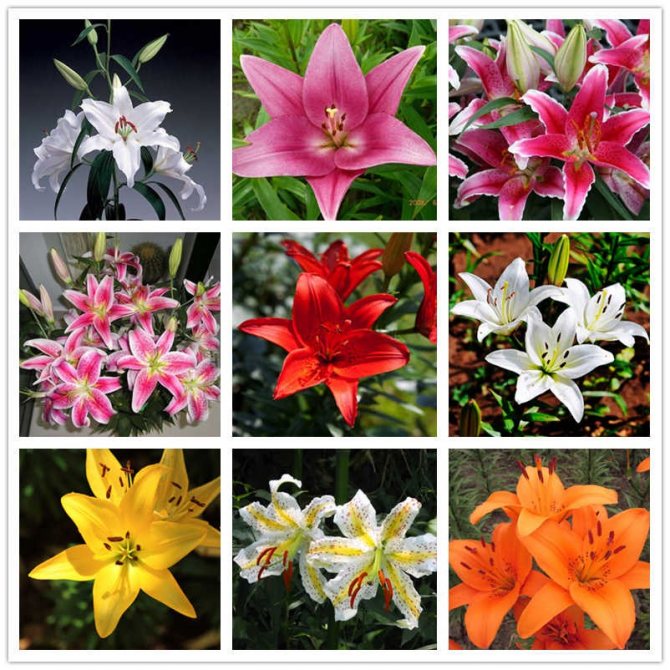

The land must be fertile and well-drained. Garden or loam is perfect.
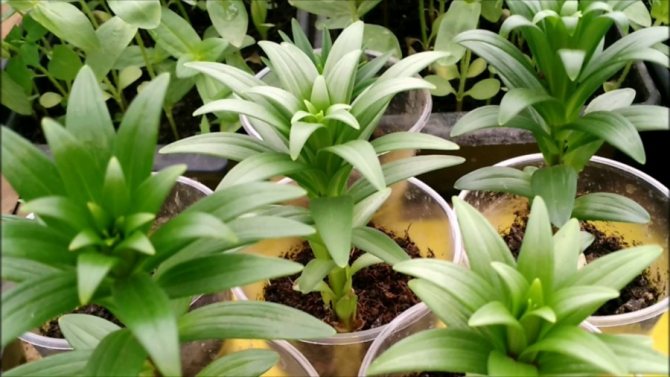

It is important to take care of the watering regime. It is necessary to spill in the mornings and evenings in such a way that moisture penetrates deeply, and does not spread over the surface. Don't overdo it: drought is much easier to tolerate.
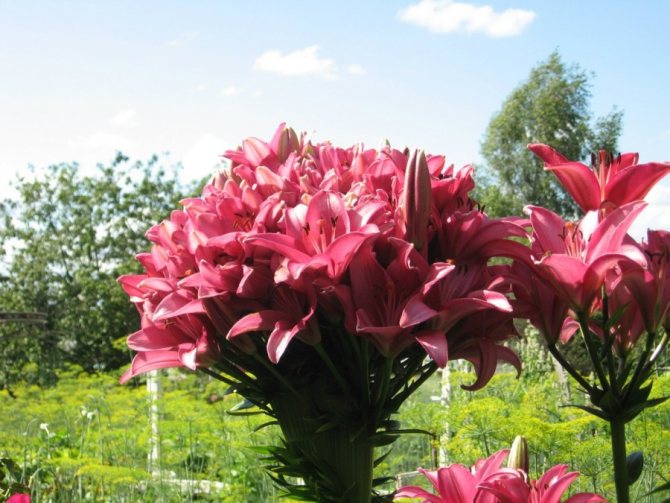

Remove weeds and loosen the surrounding area periodically.
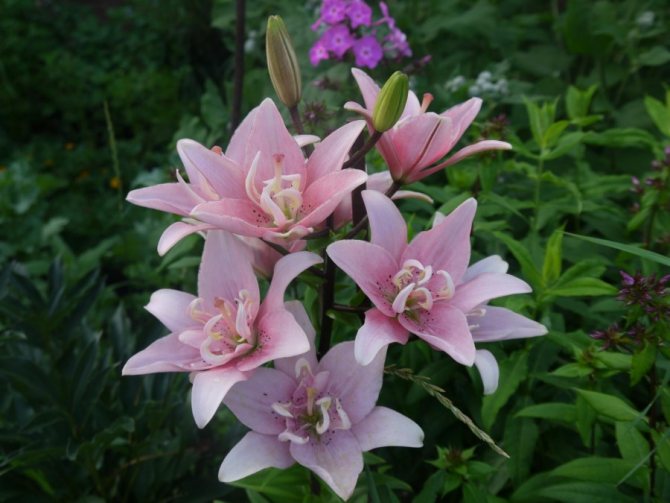

Top dressing is required in early spring and before flowering.Give preference to mineral complexes.
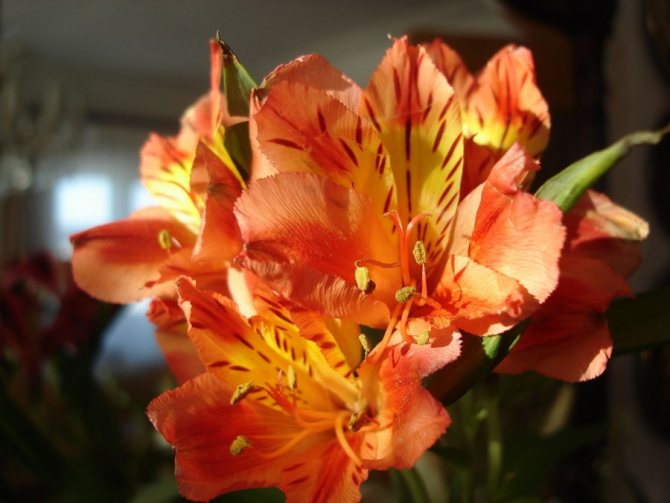

When the peduncle dries up, it can be cut off, leaving 18 cm. In November, the stump is also removed. For wintering, it is better to cover with spruce branches and leaves.
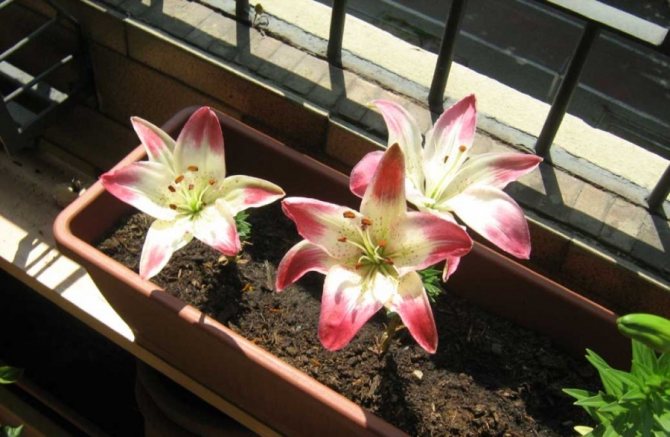

As soon as the snow begins to melt, open so that the soil warms up and the shoots develop.
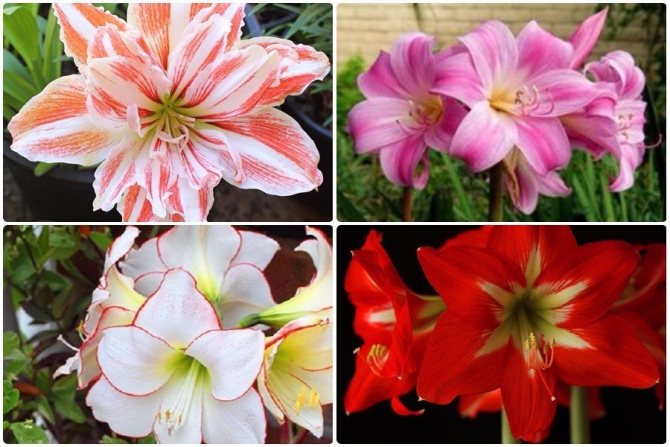

Oriental
These hybrids boast resistance to the Russian climate. Oriental hybrids have spreading inflorescences-brushes. Large fragrant flowers are directed to the side or droop down. Their shape is most often star-shaped, in diameter it can reach 25 cm and is distinguished by the wavy shape of the outer petals.
The following are varieties with photos:
Tubular (e.g. Little Fairy, Pink Perfection, Weissroy).
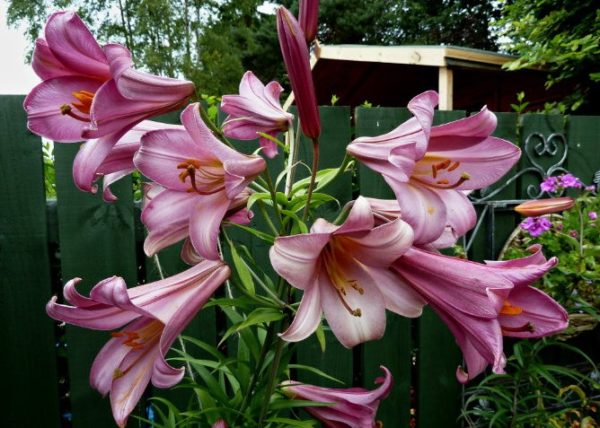

Lilies Pink Perfection
Cupped (Africa, Dusky, Lavender Lady, Red Band, Cobra and others).
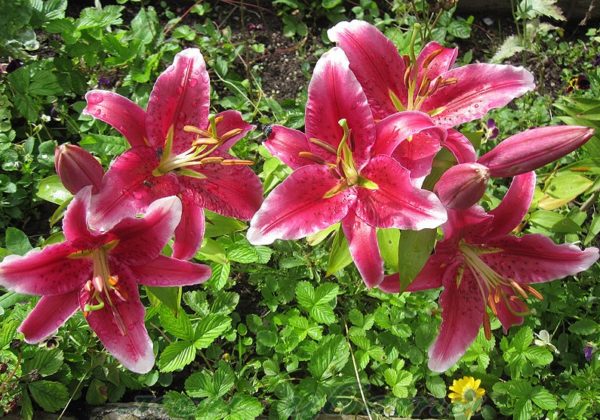

Cobra
Wide open (Jillion Wallace, Imperial Gold, Aurora, Queens Promise and others).
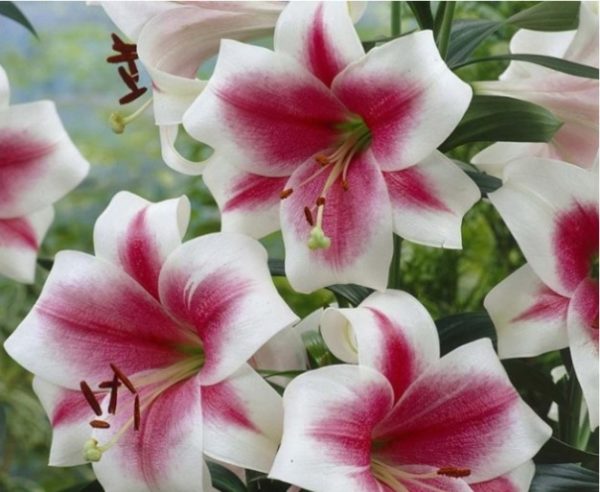

Queens promise
Chalmoid or flowers with petals bent back (for example, Allegro, Evening, Enterprise, Lady Alice and others).
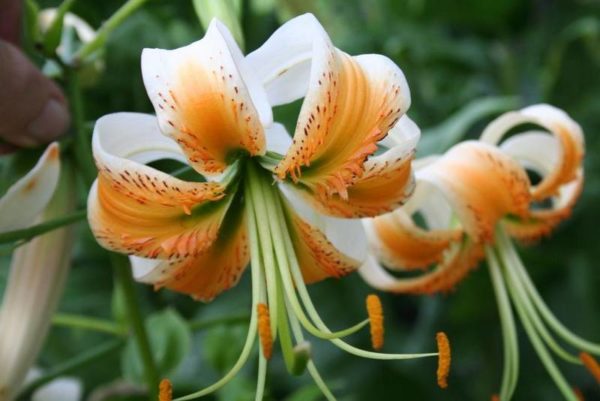

Lady Alice
The color of the petals covers all shades of pink, maybe white. Some varieties have a bright golden stripe in the center of the petals.
Short description
- Lilies are popular bulbous plants with stems topped with beautiful flowers, gathered in bunches or umbrellas.
- The bulb is made of overlapping scales that grow from the heel. The scales act as a storehouse for nutrients.
- The shoot growing from the bulb is usually one. The leaves on the shoot can be wrapped in a spiral or opposite each other.
- The most important, from the point of view of the garden owner, are flowers with a variety of cups and crowns.
- The flower has long stamens, at the ends of which there are 2 large anthers.
What are the lilies? The shape of flowers is:
- tubular (L.regale);
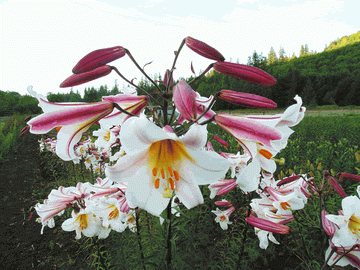

- turban-curved (L. martagon);


- bell-shaped (L.parryi);
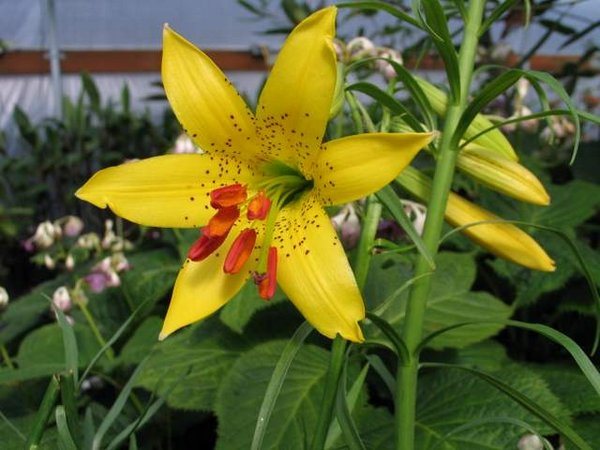

- cupped (L. bulbiferum).
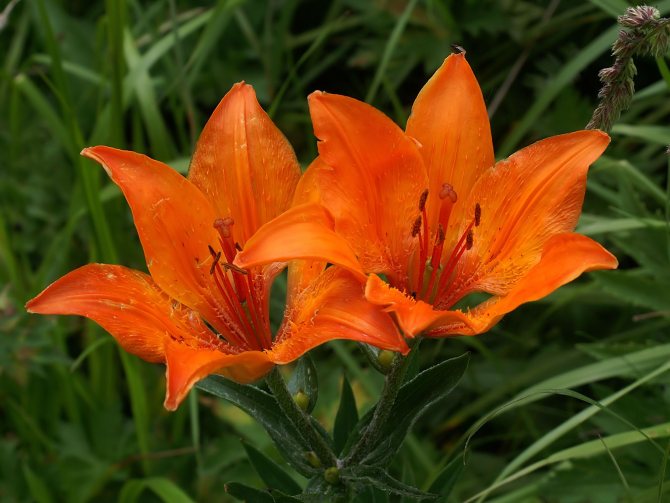

Plants are undersized and tall, flowers are smooth and double. The color variety is presented in all shades except blue.
Asian
This is the most common type, characterized by frost resistance and unpretentiousness. He has absolutely no smell, which will be a definite plus for allergy sufferers and people with a sensitive sense of smell. Growth from 40 cm to 180 cm.
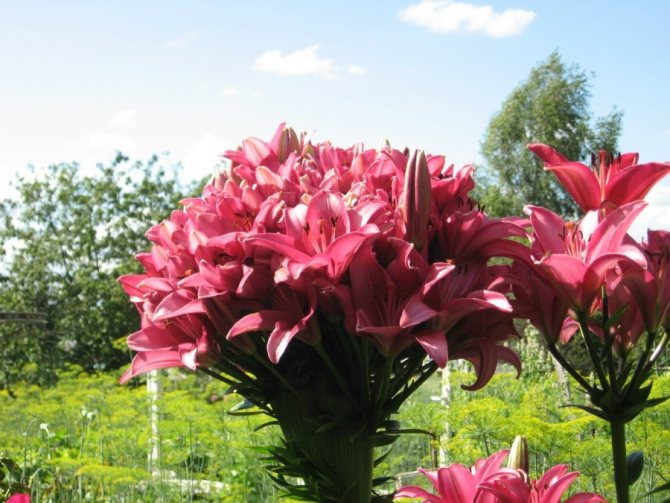

Among all, I especially want to highlight Marlene, he is also called bush. At its peak of development, it is able to form up to 200-300 buds. This multi-flowered phenomenon is explained by fasciation, i.e. a mutation characterized by the fusion of several stems into one.


The healing properties of the white lily
White Lily flower gives off an odor that can cause allergies, headaches, nausea, shortness of breath, but this plant also has many beneficial properties. For example, by infusing fresh White Lily petals in chilled boiled vegetable oil for 2.5 weeks, you can get a miracle cure for many ailments: treatment of inflamed wounds, abscesses, cracked heels, burns, pain in the ears, gangrene, lung disease, convulsions, migraines, as well as with external symptoms of gynecological diseases, hemorrhoids, from fever, painful menstruation and pain in the uterus. You can list many more diseases that such an infusion is able to cope with, and all this is due to the hemostatic, analgesic and antiseptic properties of this beautiful flower.
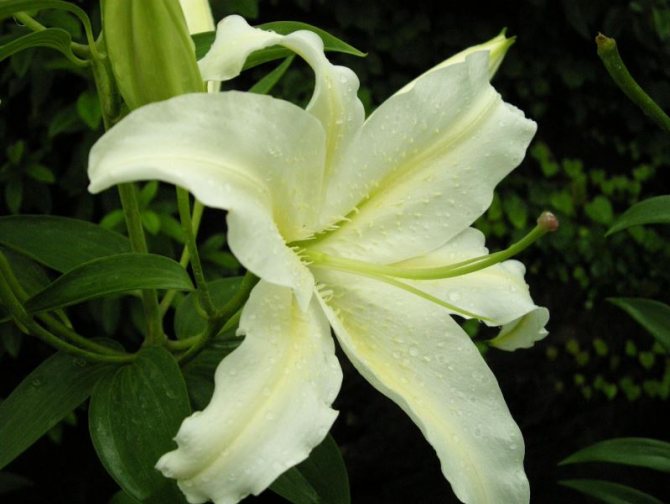

Wild species of lilies
Among the types of lilies found in nature, there are many interesting representatives that can be successfully grown in the garden:
- Curly or Saranka,


- Candidum,


- Daurskaya,


- Regal,


- Bulbous,
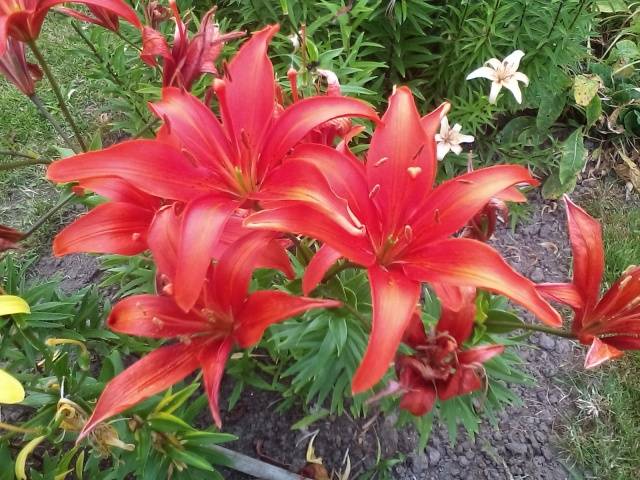

- Tiger.


Of particular interest for unpretentiousness for gardeners are the last two types.

